Assessment on Emotional Intelligence for BSB51918 Diploma of Leadership and Management
VerifiedAdded on 2022/11/15
|28
|9887
|78
AI Summary
This assessment is for BSB51918 Diploma of Leadership and Management on Emotional Intelligence. It includes written responses and report, and covers topics such as evaluation criteria, personal stressors, workplace behaviours, cultural expressions, and team performance.
Contribute Materials
Your contribution can guide someone’s learning journey. Share your
documents today.
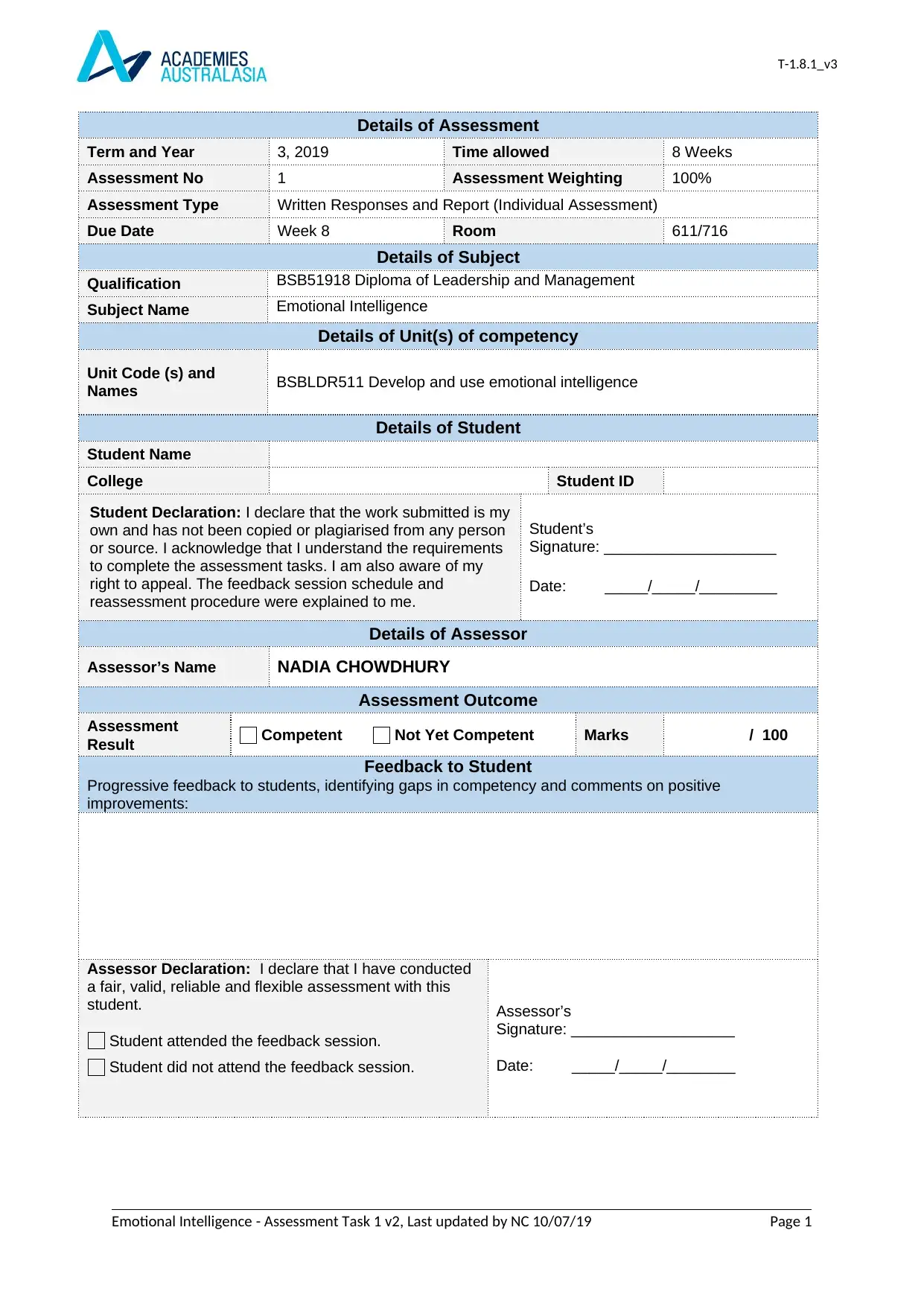
T-1.8.1_v3
Details of Assessment
Term and Year 3, 2019 Time allowed 8 Weeks
Assessment No 1 Assessment Weighting 100%
Assessment Type Written Responses and Report (Individual Assessment)
Due Date Week 8 Room 611/716
Details of Subject
Qualification BSB51918 Diploma of Leadership and Management
Subject Name Emotional Intelligence
Details of Unit(s) of competency
Unit Code (s) and
Names BSBLDR511 Develop and use emotional intelligence
Details of Student
Student Name
College Student ID
Student Declaration: I declare that the work submitted is my
own and has not been copied or plagiarised from any person
or source. I acknowledge that I understand the requirements
to complete the assessment tasks. I am also aware of my
right to appeal. The feedback session schedule and
reassessment procedure were explained to me.
Student’s
Signature: ____________________
Date: _____/_____/_________
Details of Assessor
Assessor’s Name NADIA CHOWDHURY
Assessment Outcome
Assessment
Result Competent Not Yet Competent Marks / 100
Feedback to Student
Progressive feedback to students, identifying gaps in competency and comments on positive
improvements:
Assessor Declaration: I declare that I have conducted
a fair, valid, reliable and flexible assessment with this
student.
Student attended the feedback session.
Student did not attend the feedback session.
Assessor’s
Signature: ___________________
Date: _____/_____/________
Emotional Intelligence - Assessment Task 1 v2, Last updated by NC 10/07/19 Page 1
Details of Assessment
Term and Year 3, 2019 Time allowed 8 Weeks
Assessment No 1 Assessment Weighting 100%
Assessment Type Written Responses and Report (Individual Assessment)
Due Date Week 8 Room 611/716
Details of Subject
Qualification BSB51918 Diploma of Leadership and Management
Subject Name Emotional Intelligence
Details of Unit(s) of competency
Unit Code (s) and
Names BSBLDR511 Develop and use emotional intelligence
Details of Student
Student Name
College Student ID
Student Declaration: I declare that the work submitted is my
own and has not been copied or plagiarised from any person
or source. I acknowledge that I understand the requirements
to complete the assessment tasks. I am also aware of my
right to appeal. The feedback session schedule and
reassessment procedure were explained to me.
Student’s
Signature: ____________________
Date: _____/_____/_________
Details of Assessor
Assessor’s Name NADIA CHOWDHURY
Assessment Outcome
Assessment
Result Competent Not Yet Competent Marks / 100
Feedback to Student
Progressive feedback to students, identifying gaps in competency and comments on positive
improvements:
Assessor Declaration: I declare that I have conducted
a fair, valid, reliable and flexible assessment with this
student.
Student attended the feedback session.
Student did not attend the feedback session.
Assessor’s
Signature: ___________________
Date: _____/_____/________
Emotional Intelligence - Assessment Task 1 v2, Last updated by NC 10/07/19 Page 1
Secure Best Marks with AI Grader
Need help grading? Try our AI Grader for instant feedback on your assignments.
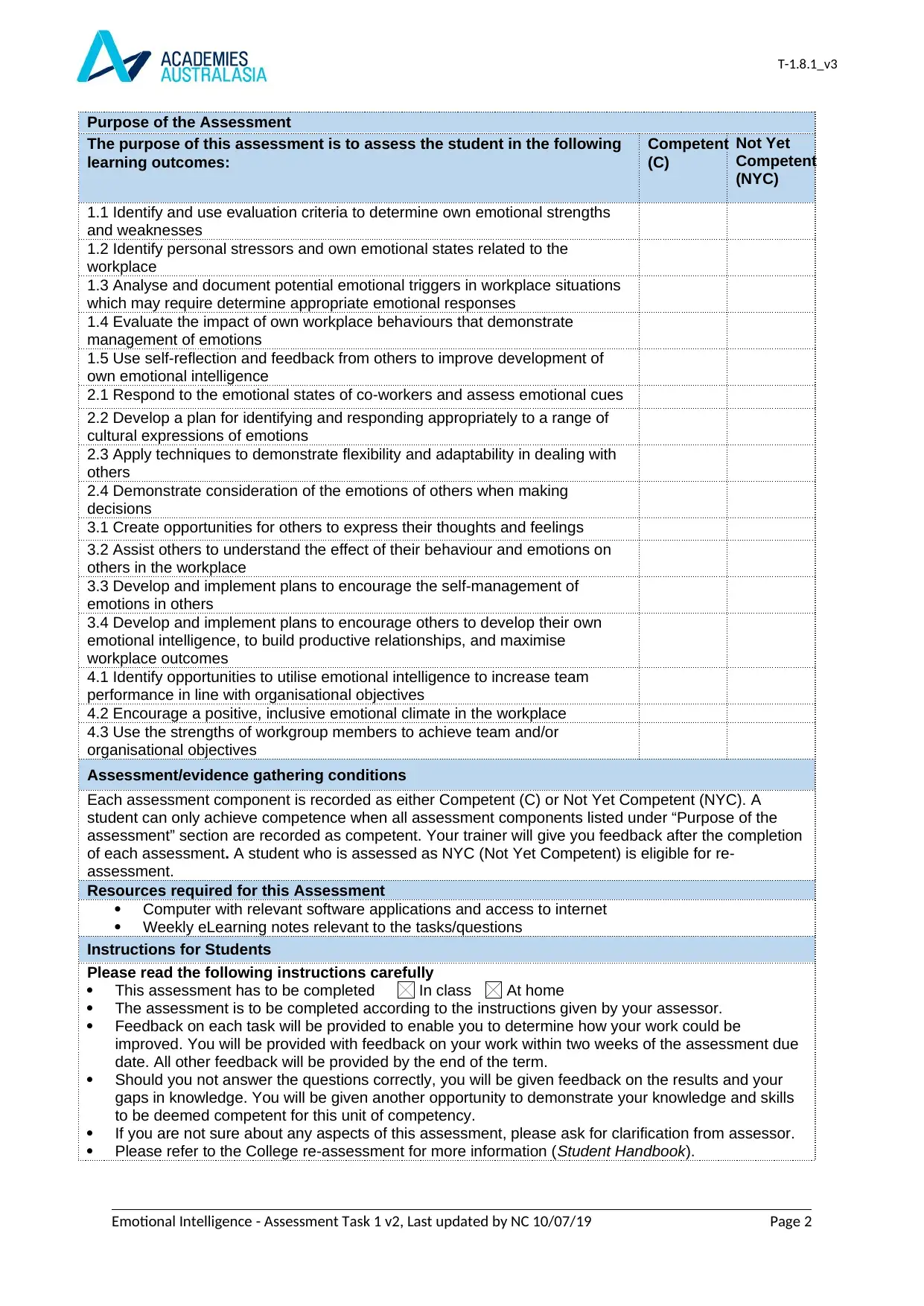
T-1.8.1_v3
Purpose of the Assessment
The purpose of this assessment is to assess the student in the following
learning outcomes:
Competent
(C)
Not Yet
Competent
(NYC)
1.1 Identify and use evaluation criteria to determine own emotional strengths
and weaknesses
1.2 Identify personal stressors and own emotional states related to the
workplace
1.3 Analyse and document potential emotional triggers in workplace situations
which may require determine appropriate emotional responses
1.4 Evaluate the impact of own workplace behaviours that demonstrate
management of emotions
1.5 Use self-reflection and feedback from others to improve development of
own emotional intelligence
2.1 Respond to the emotional states of co-workers and assess emotional cues
2.2 Develop a plan for identifying and responding appropriately to a range of
cultural expressions of emotions
2.3 Apply techniques to demonstrate flexibility and adaptability in dealing with
others
2.4 Demonstrate consideration of the emotions of others when making
decisions
3.1 Create opportunities for others to express their thoughts and feelings
3.2 Assist others to understand the effect of their behaviour and emotions on
others in the workplace
3.3 Develop and implement plans to encourage the self-management of
emotions in others
3.4 Develop and implement plans to encourage others to develop their own
emotional intelligence, to build productive relationships, and maximise
workplace outcomes
4.1 Identify opportunities to utilise emotional intelligence to increase team
performance in line with organisational objectives
4.2 Encourage a positive, inclusive emotional climate in the workplace
4.3 Use the strengths of workgroup members to achieve team and/or
organisational objectives
Assessment/evidence gathering conditions
Each assessment component is recorded as either Competent (C) or Not Yet Competent (NYC). A
student can only achieve competence when all assessment components listed under “Purpose of the
assessment” section are recorded as competent. Your trainer will give you feedback after the completion
of each assessment. A student who is assessed as NYC (Not Yet Competent) is eligible for re-
assessment.
Resources required for this Assessment
Computer with relevant software applications and access to internet
Weekly eLearning notes relevant to the tasks/questions
Instructions for Students
Please read the following instructions carefully
This assessment has to be completed In class At home
The assessment is to be completed according to the instructions given by your assessor.
Feedback on each task will be provided to enable you to determine how your work could be
improved. You will be provided with feedback on your work within two weeks of the assessment due
date. All other feedback will be provided by the end of the term.
Should you not answer the questions correctly, you will be given feedback on the results and your
gaps in knowledge. You will be given another opportunity to demonstrate your knowledge and skills
to be deemed competent for this unit of competency.
If you are not sure about any aspects of this assessment, please ask for clarification from assessor.
Please refer to the College re-assessment for more information (Student Handbook).
Emotional Intelligence - Assessment Task 1 v2, Last updated by NC 10/07/19 Page 2
Purpose of the Assessment
The purpose of this assessment is to assess the student in the following
learning outcomes:
Competent
(C)
Not Yet
Competent
(NYC)
1.1 Identify and use evaluation criteria to determine own emotional strengths
and weaknesses
1.2 Identify personal stressors and own emotional states related to the
workplace
1.3 Analyse and document potential emotional triggers in workplace situations
which may require determine appropriate emotional responses
1.4 Evaluate the impact of own workplace behaviours that demonstrate
management of emotions
1.5 Use self-reflection and feedback from others to improve development of
own emotional intelligence
2.1 Respond to the emotional states of co-workers and assess emotional cues
2.2 Develop a plan for identifying and responding appropriately to a range of
cultural expressions of emotions
2.3 Apply techniques to demonstrate flexibility and adaptability in dealing with
others
2.4 Demonstrate consideration of the emotions of others when making
decisions
3.1 Create opportunities for others to express their thoughts and feelings
3.2 Assist others to understand the effect of their behaviour and emotions on
others in the workplace
3.3 Develop and implement plans to encourage the self-management of
emotions in others
3.4 Develop and implement plans to encourage others to develop their own
emotional intelligence, to build productive relationships, and maximise
workplace outcomes
4.1 Identify opportunities to utilise emotional intelligence to increase team
performance in line with organisational objectives
4.2 Encourage a positive, inclusive emotional climate in the workplace
4.3 Use the strengths of workgroup members to achieve team and/or
organisational objectives
Assessment/evidence gathering conditions
Each assessment component is recorded as either Competent (C) or Not Yet Competent (NYC). A
student can only achieve competence when all assessment components listed under “Purpose of the
assessment” section are recorded as competent. Your trainer will give you feedback after the completion
of each assessment. A student who is assessed as NYC (Not Yet Competent) is eligible for re-
assessment.
Resources required for this Assessment
Computer with relevant software applications and access to internet
Weekly eLearning notes relevant to the tasks/questions
Instructions for Students
Please read the following instructions carefully
This assessment has to be completed In class At home
The assessment is to be completed according to the instructions given by your assessor.
Feedback on each task will be provided to enable you to determine how your work could be
improved. You will be provided with feedback on your work within two weeks of the assessment due
date. All other feedback will be provided by the end of the term.
Should you not answer the questions correctly, you will be given feedback on the results and your
gaps in knowledge. You will be given another opportunity to demonstrate your knowledge and skills
to be deemed competent for this unit of competency.
If you are not sure about any aspects of this assessment, please ask for clarification from assessor.
Please refer to the College re-assessment for more information (Student Handbook).
Emotional Intelligence - Assessment Task 1 v2, Last updated by NC 10/07/19 Page 2
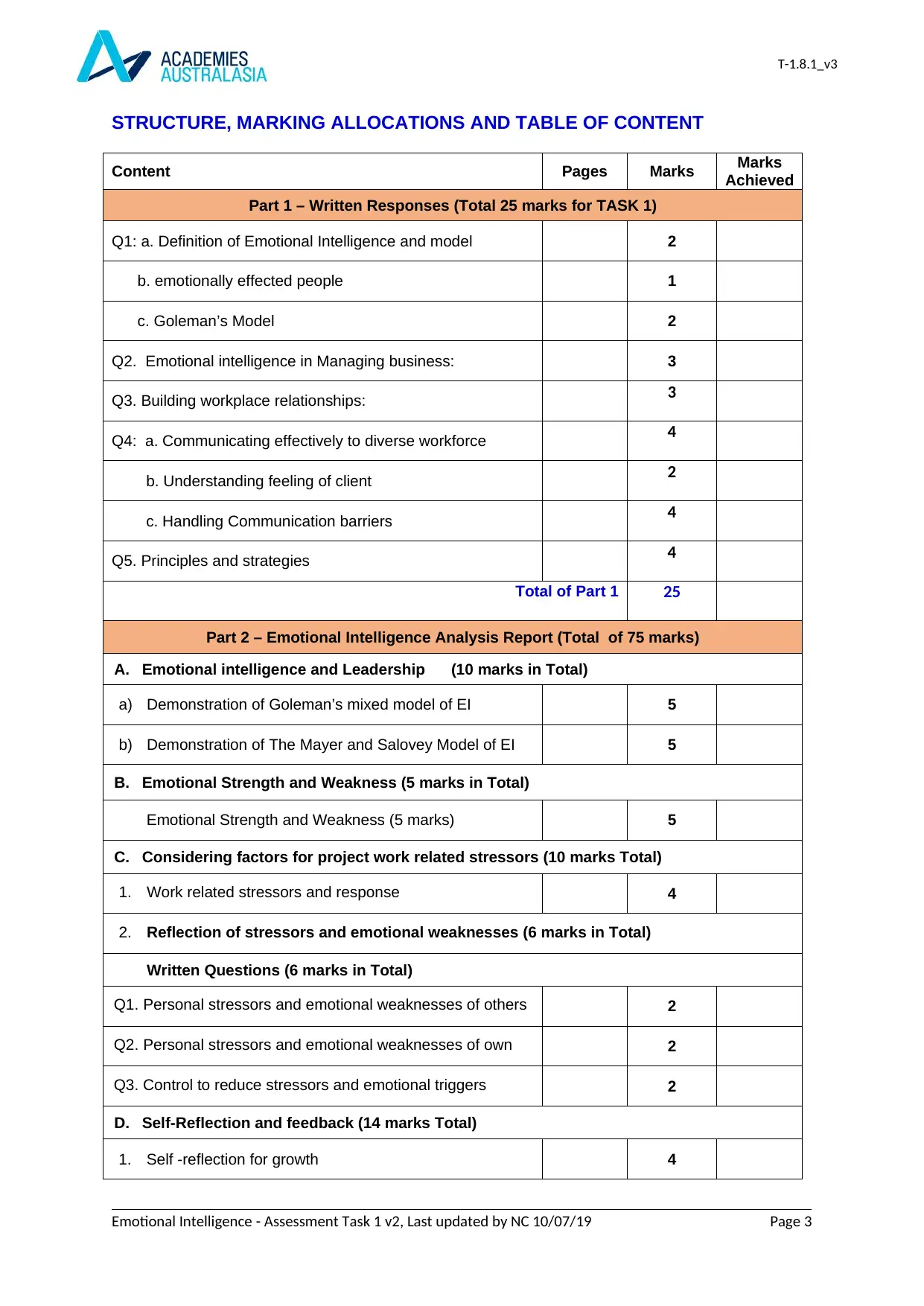
T-1.8.1_v3
STRUCTURE, MARKING ALLOCATIONS AND TABLE OF CONTENT
Content Pages Marks Marks
Achieved
Part 1 – Written Responses (Total 25 marks for TASK 1)
Q1: a. Definition of Emotional Intelligence and model 2
b. emotionally effected people 1
c. Goleman’s Model 2
Q2. Emotional intelligence in Managing business: 3
Q3. Building workplace relationships: 3
Q4: a. Communicating effectively to diverse workforce 4
b. Understanding feeling of client 2
c. Handling Communication barriers 4
Q5. Principles and strategies 4
Total of Part 1 25
Part 2 – Emotional Intelligence Analysis Report (Total of 75 marks)
A. Emotional intelligence and Leadership (10 marks in Total)
a) Demonstration of Goleman’s mixed model of EI 5
b) Demonstration of The Mayer and Salovey Model of EI 5
B. Emotional Strength and Weakness (5 marks in Total)
Emotional Strength and Weakness (5 marks) 5
C. Considering factors for project work related stressors (10 marks Total)
1. Work related stressors and response 4
2. Reflection of stressors and emotional weaknesses (6 marks in Total)
Written Questions (6 marks in Total)
Q1. Personal stressors and emotional weaknesses of others 2
Q2. Personal stressors and emotional weaknesses of own 2
Q3. Control to reduce stressors and emotional triggers 2
D. Self-Reflection and feedback (14 marks Total)
1. Self -reflection for growth 4
Emotional Intelligence - Assessment Task 1 v2, Last updated by NC 10/07/19 Page 3
STRUCTURE, MARKING ALLOCATIONS AND TABLE OF CONTENT
Content Pages Marks Marks
Achieved
Part 1 – Written Responses (Total 25 marks for TASK 1)
Q1: a. Definition of Emotional Intelligence and model 2
b. emotionally effected people 1
c. Goleman’s Model 2
Q2. Emotional intelligence in Managing business: 3
Q3. Building workplace relationships: 3
Q4: a. Communicating effectively to diverse workforce 4
b. Understanding feeling of client 2
c. Handling Communication barriers 4
Q5. Principles and strategies 4
Total of Part 1 25
Part 2 – Emotional Intelligence Analysis Report (Total of 75 marks)
A. Emotional intelligence and Leadership (10 marks in Total)
a) Demonstration of Goleman’s mixed model of EI 5
b) Demonstration of The Mayer and Salovey Model of EI 5
B. Emotional Strength and Weakness (5 marks in Total)
Emotional Strength and Weakness (5 marks) 5
C. Considering factors for project work related stressors (10 marks Total)
1. Work related stressors and response 4
2. Reflection of stressors and emotional weaknesses (6 marks in Total)
Written Questions (6 marks in Total)
Q1. Personal stressors and emotional weaknesses of others 2
Q2. Personal stressors and emotional weaknesses of own 2
Q3. Control to reduce stressors and emotional triggers 2
D. Self-Reflection and feedback (14 marks Total)
1. Self -reflection for growth 4
Emotional Intelligence - Assessment Task 1 v2, Last updated by NC 10/07/19 Page 3
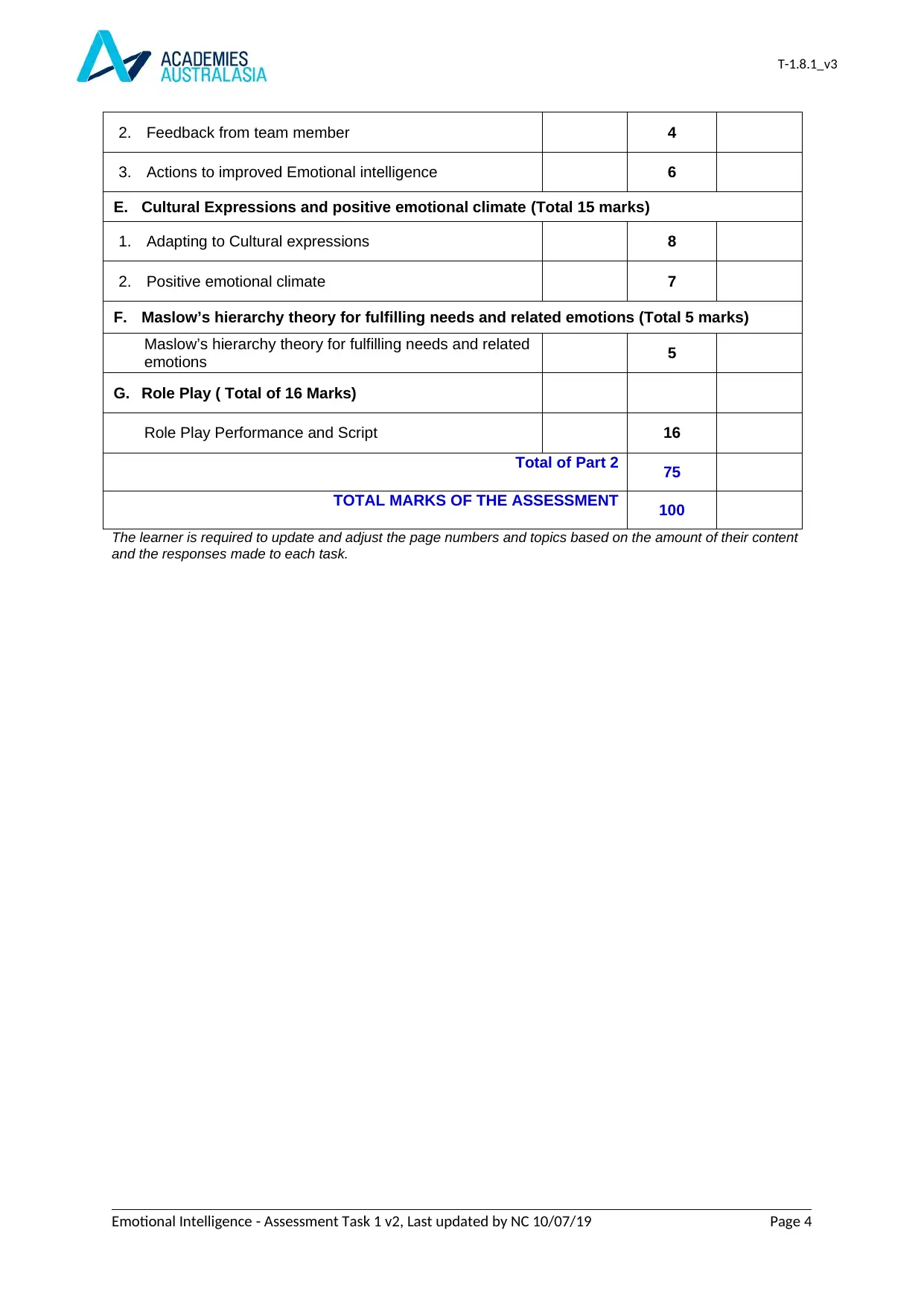
T-1.8.1_v3
2. Feedback from team member 4
3. Actions to improved Emotional intelligence 6
E. Cultural Expressions and positive emotional climate (Total 15 marks)
1. Adapting to Cultural expressions 8
2. Positive emotional climate 7
F. Maslow’s hierarchy theory for fulfilling needs and related emotions (Total 5 marks)
Maslow’s hierarchy theory for fulfilling needs and related
emotions 5
G. Role Play ( Total of 16 Marks)
Role Play Performance and Script 16
Total of Part 2 75
TOTAL MARKS OF THE ASSESSMENT 100
The learner is required to update and adjust the page numbers and topics based on the amount of their content
and the responses made to each task.
Emotional Intelligence - Assessment Task 1 v2, Last updated by NC 10/07/19 Page 4
2. Feedback from team member 4
3. Actions to improved Emotional intelligence 6
E. Cultural Expressions and positive emotional climate (Total 15 marks)
1. Adapting to Cultural expressions 8
2. Positive emotional climate 7
F. Maslow’s hierarchy theory for fulfilling needs and related emotions (Total 5 marks)
Maslow’s hierarchy theory for fulfilling needs and related
emotions 5
G. Role Play ( Total of 16 Marks)
Role Play Performance and Script 16
Total of Part 2 75
TOTAL MARKS OF THE ASSESSMENT 100
The learner is required to update and adjust the page numbers and topics based on the amount of their content
and the responses made to each task.
Emotional Intelligence - Assessment Task 1 v2, Last updated by NC 10/07/19 Page 4
Secure Best Marks with AI Grader
Need help grading? Try our AI Grader for instant feedback on your assignments.

T-1.8.1_v3
PART 1– KNOWLEDGE EVIDENCE WRITTEN RESPONSES
This part of assessment comprises the knowledge testing required for the unit BSBLDR511. 5
knowledge questions and you must ANSWER ALL. Use the spaces below to respond to the
questions. Weights and marking allocations are in the marking allocating table.
This assessment has been established with the aim to measure your knowledge, and attributes
emotional intelligence principles and strategies, the relationship between emotionally effective people
and the attainment of business objectives, how to communicate with a diverse workforce which has
varying cultural expressions of emotion and explain the use of emotional intelligence in the context of
building workplace relationships.
Answer the following questions in the appropriate spaces below:
All responses must:
This activity has been designed to assess your knowledge and understanding of leading and
managing a team in the context of emotional intelligence within business organisations.
Question 1: Definition, model and dimensions: Define Emotional Intelligence? Explain in your own
words. Who are emotionally effected people? Based on the Model of Emotional Intelligence’ by Daniel
Goleman’s, how can you as a leader develop the dimensions of this model in the context of a
business environment?
a. Emotional intelligence definition (2 marks)
Emotional intelligence, also known as EI can be defined as a person’s ability to comprehend and then
manage one’s own flow of emotions while reinforcing the emotional quotient of other people as well.
The individual who possess a very high level of this intelligence know what they are feeling and also,
how their emotions can influence other people, present in the surrounding.
b. Emotionally effected people: (1 Mark )
On the contrary, people who has low level of emotional intelligence can easily get affected for lack the
essential skills required to manage their own and that of others. Hence, affection results for lack of
being able to overcome or avoid it.
c. Goleman’s model application on a business environment: (2 Marks)
The Goleman’s model incorporates five different aspects such as self-motivation, empathy, social
skills, self-regulation and self-awareness which can used by the managers and leaders in the most
appropriate way in order to build the right teams, the right mix of professionals for a certain project
and micromanage individuals effectively.
Emotional Intelligence - Assessment Task 1 v2, Last updated by NC 10/07/19 Page 5
PART 1– KNOWLEDGE EVIDENCE WRITTEN RESPONSES
This part of assessment comprises the knowledge testing required for the unit BSBLDR511. 5
knowledge questions and you must ANSWER ALL. Use the spaces below to respond to the
questions. Weights and marking allocations are in the marking allocating table.
This assessment has been established with the aim to measure your knowledge, and attributes
emotional intelligence principles and strategies, the relationship between emotionally effective people
and the attainment of business objectives, how to communicate with a diverse workforce which has
varying cultural expressions of emotion and explain the use of emotional intelligence in the context of
building workplace relationships.
Answer the following questions in the appropriate spaces below:
All responses must:
This activity has been designed to assess your knowledge and understanding of leading and
managing a team in the context of emotional intelligence within business organisations.
Question 1: Definition, model and dimensions: Define Emotional Intelligence? Explain in your own
words. Who are emotionally effected people? Based on the Model of Emotional Intelligence’ by Daniel
Goleman’s, how can you as a leader develop the dimensions of this model in the context of a
business environment?
a. Emotional intelligence definition (2 marks)
Emotional intelligence, also known as EI can be defined as a person’s ability to comprehend and then
manage one’s own flow of emotions while reinforcing the emotional quotient of other people as well.
The individual who possess a very high level of this intelligence know what they are feeling and also,
how their emotions can influence other people, present in the surrounding.
b. Emotionally effected people: (1 Mark )
On the contrary, people who has low level of emotional intelligence can easily get affected for lack the
essential skills required to manage their own and that of others. Hence, affection results for lack of
being able to overcome or avoid it.
c. Goleman’s model application on a business environment: (2 Marks)
The Goleman’s model incorporates five different aspects such as self-motivation, empathy, social
skills, self-regulation and self-awareness which can used by the managers and leaders in the most
appropriate way in order to build the right teams, the right mix of professionals for a certain project
and micromanage individuals effectively.
Emotional Intelligence - Assessment Task 1 v2, Last updated by NC 10/07/19 Page 5
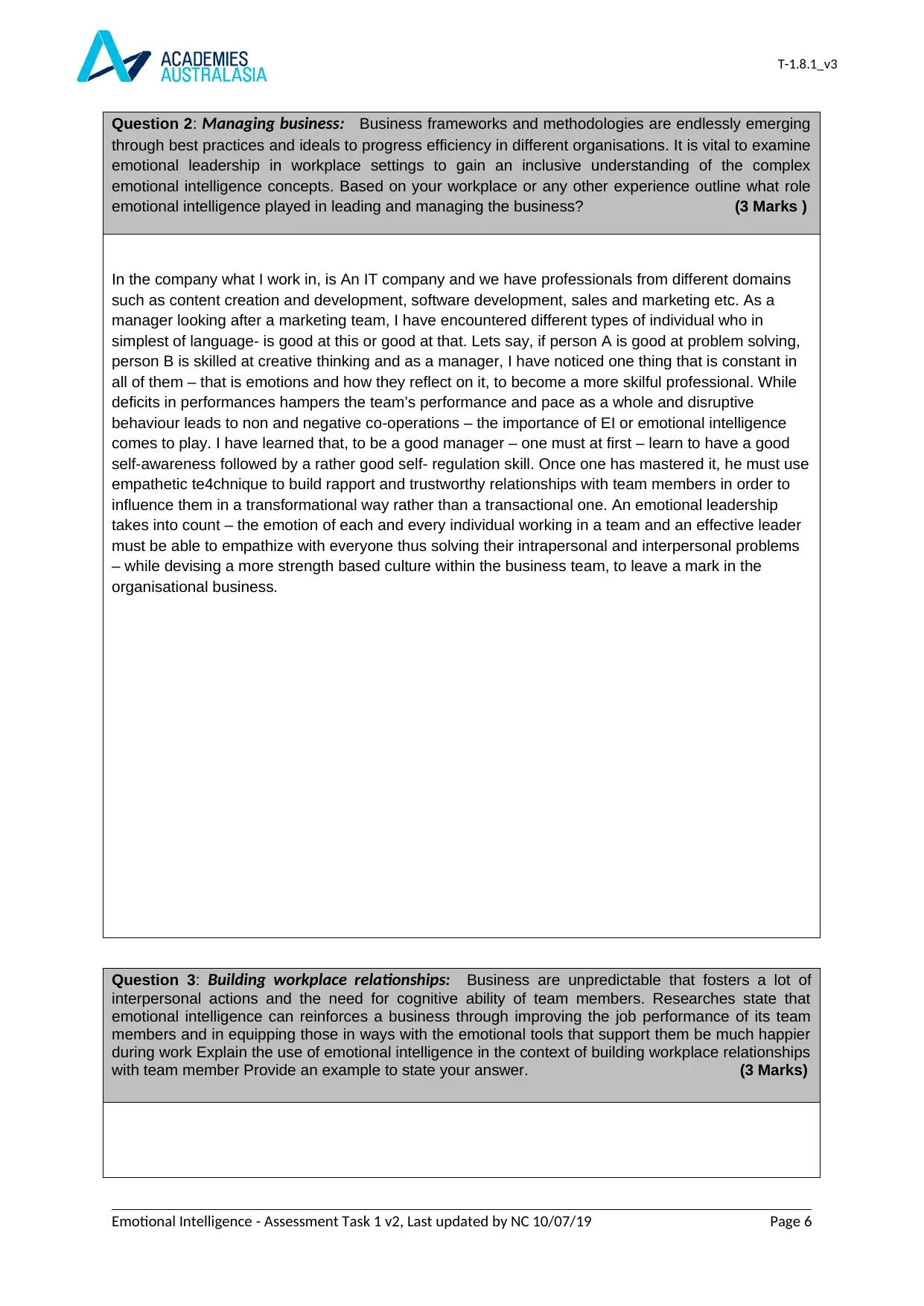
T-1.8.1_v3
Question 2: Managing business: Business frameworks and methodologies are endlessly emerging
through best practices and ideals to progress efficiency in different organisations. It is vital to examine
emotional leadership in workplace settings to gain an inclusive understanding of the complex
emotional intelligence concepts. Based on your workplace or any other experience outline what role
emotional intelligence played in leading and managing the business? (3 Marks )
In the company what I work in, is An IT company and we have professionals from different domains
such as content creation and development, software development, sales and marketing etc. As a
manager looking after a marketing team, I have encountered different types of individual who in
simplest of language- is good at this or good at that. Lets say, if person A is good at problem solving,
person B is skilled at creative thinking and as a manager, I have noticed one thing that is constant in
all of them – that is emotions and how they reflect on it, to become a more skilful professional. While
deficits in performances hampers the team’s performance and pace as a whole and disruptive
behaviour leads to non and negative co-operations – the importance of EI or emotional intelligence
comes to play. I have learned that, to be a good manager – one must at first – learn to have a good
self-awareness followed by a rather good self- regulation skill. Once one has mastered it, he must use
empathetic te4chnique to build rapport and trustworthy relationships with team members in order to
influence them in a transformational way rather than a transactional one. An emotional leadership
takes into count – the emotion of each and every individual working in a team and an effective leader
must be able to empathize with everyone thus solving their intrapersonal and interpersonal problems
– while devising a more strength based culture within the business team, to leave a mark in the
organisational business.
Question 3: Building workplace relationships: Business are unpredictable that fosters a lot of
interpersonal actions and the need for cognitive ability of team members. Researches state that
emotional intelligence can reinforces a business through improving the job performance of its team
members and in equipping those in ways with the emotional tools that support them be much happier
during work Explain the use of emotional intelligence in the context of building workplace relationships
with team member Provide an example to state your answer. (3 Marks)
Emotional Intelligence - Assessment Task 1 v2, Last updated by NC 10/07/19 Page 6
Question 2: Managing business: Business frameworks and methodologies are endlessly emerging
through best practices and ideals to progress efficiency in different organisations. It is vital to examine
emotional leadership in workplace settings to gain an inclusive understanding of the complex
emotional intelligence concepts. Based on your workplace or any other experience outline what role
emotional intelligence played in leading and managing the business? (3 Marks )
In the company what I work in, is An IT company and we have professionals from different domains
such as content creation and development, software development, sales and marketing etc. As a
manager looking after a marketing team, I have encountered different types of individual who in
simplest of language- is good at this or good at that. Lets say, if person A is good at problem solving,
person B is skilled at creative thinking and as a manager, I have noticed one thing that is constant in
all of them – that is emotions and how they reflect on it, to become a more skilful professional. While
deficits in performances hampers the team’s performance and pace as a whole and disruptive
behaviour leads to non and negative co-operations – the importance of EI or emotional intelligence
comes to play. I have learned that, to be a good manager – one must at first – learn to have a good
self-awareness followed by a rather good self- regulation skill. Once one has mastered it, he must use
empathetic te4chnique to build rapport and trustworthy relationships with team members in order to
influence them in a transformational way rather than a transactional one. An emotional leadership
takes into count – the emotion of each and every individual working in a team and an effective leader
must be able to empathize with everyone thus solving their intrapersonal and interpersonal problems
– while devising a more strength based culture within the business team, to leave a mark in the
organisational business.
Question 3: Building workplace relationships: Business are unpredictable that fosters a lot of
interpersonal actions and the need for cognitive ability of team members. Researches state that
emotional intelligence can reinforces a business through improving the job performance of its team
members and in equipping those in ways with the emotional tools that support them be much happier
during work Explain the use of emotional intelligence in the context of building workplace relationships
with team member Provide an example to state your answer. (3 Marks)
Emotional Intelligence - Assessment Task 1 v2, Last updated by NC 10/07/19 Page 6

T-1.8.1_v3
Emotional states can surely affect the pace at which an individual professional performs and in whole,
how the entire team performs. Certain EI enhancement tools such as motivation, empathy, positive
discussions and emotional release can surely help a leader assist in personal and professional
developments of team members. While reinforcements and ‘associative ;earning’ can be used as
important ‘conditioning tools’ in order to better the personal and professional excellence of employees
– it is also to be remembered that self-identity, social identity are important aspects that are to be
empowered as well, by the leader in order to maximise the performance level of every individual in the
team.
As for example, I was managing an individual named Charles who had great attention to details and
improvisation skills when it came to meeting the clients and closing the deal. But as it stood out, he
was not being able to perform that well after a certain period of time and this is where I intervened and
came to know, that he had been suffering from deep ‘emotional connect’ issues and relationship
problems. I started by empathizing with them and started to motivate him to take up this life’s
challenges positively and turn it around – to which he responded and as I said I believed he could do
it – as a matter of fact, he started taking charge of his life and was successful at changing it.
Emotional Intelligence - Assessment Task 1 v2, Last updated by NC 10/07/19 Page 7
Emotional states can surely affect the pace at which an individual professional performs and in whole,
how the entire team performs. Certain EI enhancement tools such as motivation, empathy, positive
discussions and emotional release can surely help a leader assist in personal and professional
developments of team members. While reinforcements and ‘associative ;earning’ can be used as
important ‘conditioning tools’ in order to better the personal and professional excellence of employees
– it is also to be remembered that self-identity, social identity are important aspects that are to be
empowered as well, by the leader in order to maximise the performance level of every individual in the
team.
As for example, I was managing an individual named Charles who had great attention to details and
improvisation skills when it came to meeting the clients and closing the deal. But as it stood out, he
was not being able to perform that well after a certain period of time and this is where I intervened and
came to know, that he had been suffering from deep ‘emotional connect’ issues and relationship
problems. I started by empathizing with them and started to motivate him to take up this life’s
challenges positively and turn it around – to which he responded and as I said I believed he could do
it – as a matter of fact, he started taking charge of his life and was successful at changing it.
Emotional Intelligence - Assessment Task 1 v2, Last updated by NC 10/07/19 Page 7
Paraphrase This Document
Need a fresh take? Get an instant paraphrase of this document with our AI Paraphraser
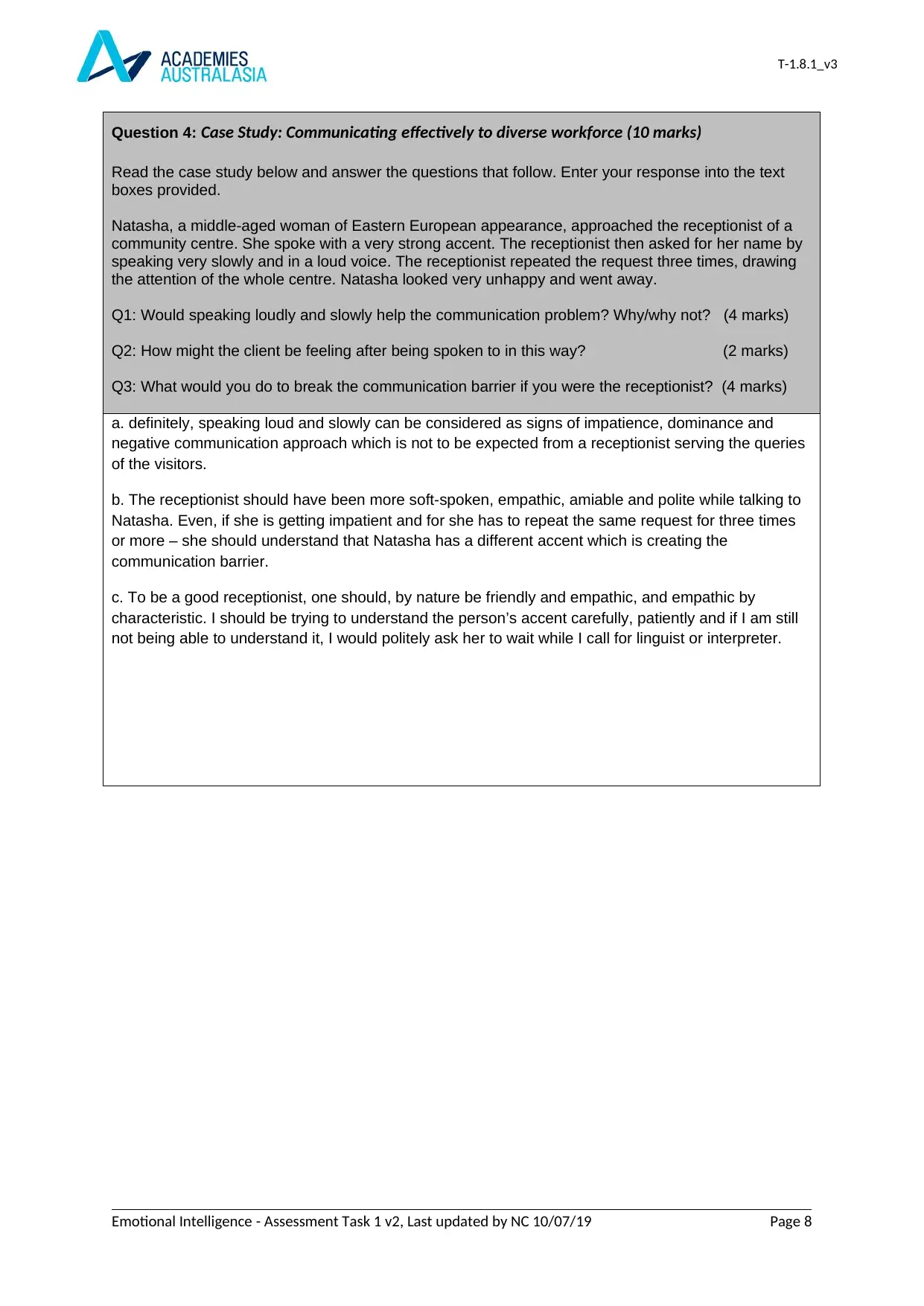
T-1.8.1_v3
Emotional Intelligence - Assessment Task 1 v2, Last updated by NC 10/07/19 Page 8
Question 4: Case Study: Communicating effectively to diverse workforce (10 marks)
Read the case study below and answer the questions that follow. Enter your response into the text
boxes provided.
Natasha, a middle-aged woman of Eastern European appearance, approached the receptionist of a
community centre. She spoke with a very strong accent. The receptionist then asked for her name by
speaking very slowly and in a loud voice. The receptionist repeated the request three times, drawing
the attention of the whole centre. Natasha looked very unhappy and went away.
Q1: Would speaking loudly and slowly help the communication problem? Why/why not? (4 marks)
Q2: How might the client be feeling after being spoken to in this way? (2 marks)
Q3: What would you do to break the communication barrier if you were the receptionist? (4 marks)
a. definitely, speaking loud and slowly can be considered as signs of impatience, dominance and
negative communication approach which is not to be expected from a receptionist serving the queries
of the visitors.
b. The receptionist should have been more soft-spoken, empathic, amiable and polite while talking to
Natasha. Even, if she is getting impatient and for she has to repeat the same request for three times
or more – she should understand that Natasha has a different accent which is creating the
communication barrier.
c. To be a good receptionist, one should, by nature be friendly and empathic, and empathic by
characteristic. I should be trying to understand the person’s accent carefully, patiently and if I am still
not being able to understand it, I would politely ask her to wait while I call for linguist or interpreter.
Emotional Intelligence - Assessment Task 1 v2, Last updated by NC 10/07/19 Page 8
Question 4: Case Study: Communicating effectively to diverse workforce (10 marks)
Read the case study below and answer the questions that follow. Enter your response into the text
boxes provided.
Natasha, a middle-aged woman of Eastern European appearance, approached the receptionist of a
community centre. She spoke with a very strong accent. The receptionist then asked for her name by
speaking very slowly and in a loud voice. The receptionist repeated the request three times, drawing
the attention of the whole centre. Natasha looked very unhappy and went away.
Q1: Would speaking loudly and slowly help the communication problem? Why/why not? (4 marks)
Q2: How might the client be feeling after being spoken to in this way? (2 marks)
Q3: What would you do to break the communication barrier if you were the receptionist? (4 marks)
a. definitely, speaking loud and slowly can be considered as signs of impatience, dominance and
negative communication approach which is not to be expected from a receptionist serving the queries
of the visitors.
b. The receptionist should have been more soft-spoken, empathic, amiable and polite while talking to
Natasha. Even, if she is getting impatient and for she has to repeat the same request for three times
or more – she should understand that Natasha has a different accent which is creating the
communication barrier.
c. To be a good receptionist, one should, by nature be friendly and empathic, and empathic by
characteristic. I should be trying to understand the person’s accent carefully, patiently and if I am still
not being able to understand it, I would politely ask her to wait while I call for linguist or interpreter.

T-1.8.1_v3
PART 2 - WORKPLACE SCENARIO BASED ON A CASE
ORGANISATION- PORTFOLIO OF EVIDENCE
SIMULATED WORK ORGANISATION:
The portfolio of evidence comprises the assessment of the application of your emotional
intelligence usage knowledge whilst managing a project and its team. You will use the given case
study below and will need to demonstrate your emotional intelligence to increase self-awareness,
self-management, social awareness and relationship management as well as identifying the impact
of own emotions on others whilst managing your team applied to any workplace.
Emotional Intelligence - Assessment Task 1 v2, Last updated by NC 10/07/19 Page 9
Question 5: Principles and strategies: Considering the reflection of your personal attributes,
impact on others and/or adjustment of your tactics to support your development, outline a situation
from your workplace or any other experience, when you exemplified model of workplace behaviour
signifying management of emotions as an illustration for your team members/workmates/classmates
to follow. (You may refer to emotional principles and strategies and/or impact of your own emotions on
others and their feedback in your response)
(4 Marks)
Given my personal attributes while are active listening, creative thinking, empathic behaviour, self-
motivation, enthusiastic and moralistic – I use all of my skills to reinforce my overall daily experiences
and from the reflection of it, I contribute to my personal growth and professional growth of others.
About one year ago, our team came across several shortcomings such as attrition, terminations of
employees and low revenue generation which deeply affected the morale of the entire team. At first, I
took a group counselling session and performed interpersonal empathy building exercises that
strengthened the positive tie4s of the group and transformed the negative or neutral ones. Followed
by that, I had a one-on-one talk session where I tried to comprehend the emotional and cognitive
states of each and every individual in our team while taking perspective on how to solve the situation
which was getting difficult. When I came out with revised ethical practices to be followed by everyone
including me as a leader, they appreciate the ‘change’ for the new guidelines included ‘points’ made
by someone or other which in whole, made them feel valued and added to their socio – emotional
needs.
PART 2 - WORKPLACE SCENARIO BASED ON A CASE
ORGANISATION- PORTFOLIO OF EVIDENCE
SIMULATED WORK ORGANISATION:
The portfolio of evidence comprises the assessment of the application of your emotional
intelligence usage knowledge whilst managing a project and its team. You will use the given case
study below and will need to demonstrate your emotional intelligence to increase self-awareness,
self-management, social awareness and relationship management as well as identifying the impact
of own emotions on others whilst managing your team applied to any workplace.
Emotional Intelligence - Assessment Task 1 v2, Last updated by NC 10/07/19 Page 9
Question 5: Principles and strategies: Considering the reflection of your personal attributes,
impact on others and/or adjustment of your tactics to support your development, outline a situation
from your workplace or any other experience, when you exemplified model of workplace behaviour
signifying management of emotions as an illustration for your team members/workmates/classmates
to follow. (You may refer to emotional principles and strategies and/or impact of your own emotions on
others and their feedback in your response)
(4 Marks)
Given my personal attributes while are active listening, creative thinking, empathic behaviour, self-
motivation, enthusiastic and moralistic – I use all of my skills to reinforce my overall daily experiences
and from the reflection of it, I contribute to my personal growth and professional growth of others.
About one year ago, our team came across several shortcomings such as attrition, terminations of
employees and low revenue generation which deeply affected the morale of the entire team. At first, I
took a group counselling session and performed interpersonal empathy building exercises that
strengthened the positive tie4s of the group and transformed the negative or neutral ones. Followed
by that, I had a one-on-one talk session where I tried to comprehend the emotional and cognitive
states of each and every individual in our team while taking perspective on how to solve the situation
which was getting difficult. When I came out with revised ethical practices to be followed by everyone
including me as a leader, they appreciate the ‘change’ for the new guidelines included ‘points’ made
by someone or other which in whole, made them feel valued and added to their socio – emotional
needs.
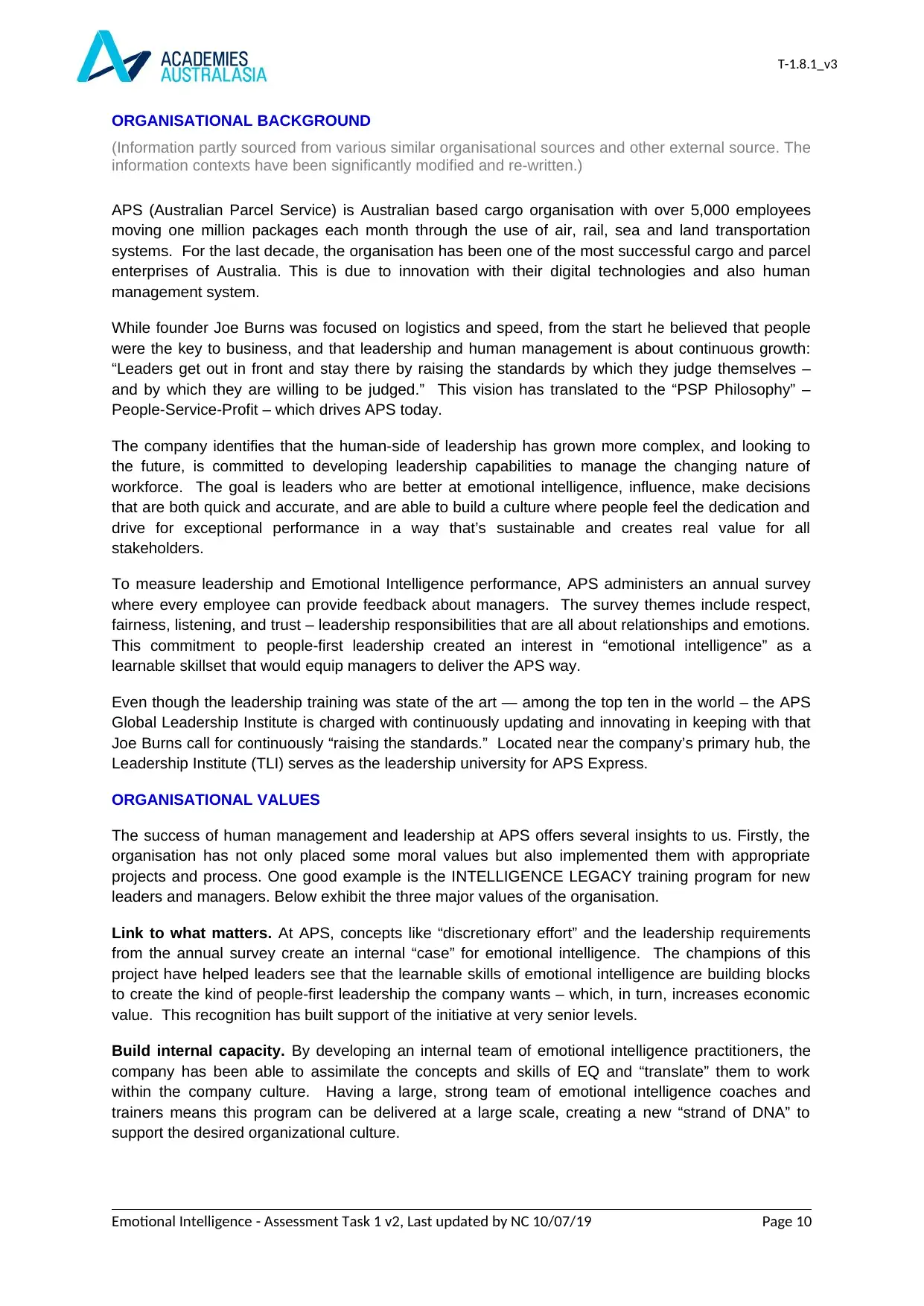
T-1.8.1_v3
ORGANISATIONAL BACKGROUND
(Information partly sourced from various similar organisational sources and other external source. The
information contexts have been significantly modified and re-written.)
APS (Australian Parcel Service) is Australian based cargo organisation with over 5,000 employees
moving one million packages each month through the use of air, rail, sea and land transportation
systems. For the last decade, the organisation has been one of the most successful cargo and parcel
enterprises of Australia. This is due to innovation with their digital technologies and also human
management system.
While founder Joe Burns was focused on logistics and speed, from the start he believed that people
were the key to business, and that leadership and human management is about continuous growth:
“Leaders get out in front and stay there by raising the standards by which they judge themselves –
and by which they are willing to be judged.” This vision has translated to the “PSP Philosophy” –
People-Service-Profit – which drives APS today.
The company identifies that the human-side of leadership has grown more complex, and looking to
the future, is committed to developing leadership capabilities to manage the changing nature of
workforce. The goal is leaders who are better at emotional intelligence, influence, make decisions
that are both quick and accurate, and are able to build a culture where people feel the dedication and
drive for exceptional performance in a way that’s sustainable and creates real value for all
stakeholders.
To measure leadership and Emotional Intelligence performance, APS administers an annual survey
where every employee can provide feedback about managers. The survey themes include respect,
fairness, listening, and trust – leadership responsibilities that are all about relationships and emotions.
This commitment to people-first leadership created an interest in “emotional intelligence” as a
learnable skillset that would equip managers to deliver the APS way.
Even though the leadership training was state of the art — among the top ten in the world – the APS
Global Leadership Institute is charged with continuously updating and innovating in keeping with that
Joe Burns call for continuously “raising the standards.” Located near the company’s primary hub, the
Leadership Institute (TLI) serves as the leadership university for APS Express.
ORGANISATIONAL VALUES
The success of human management and leadership at APS offers several insights to us. Firstly, the
organisation has not only placed some moral values but also implemented them with appropriate
projects and process. One good example is the INTELLIGENCE LEGACY training program for new
leaders and managers. Below exhibit the three major values of the organisation.
Link to what matters. At APS, concepts like “discretionary effort” and the leadership requirements
from the annual survey create an internal “case” for emotional intelligence. The champions of this
project have helped leaders see that the learnable skills of emotional intelligence are building blocks
to create the kind of people-first leadership the company wants – which, in turn, increases economic
value. This recognition has built support of the initiative at very senior levels.
Build internal capacity. By developing an internal team of emotional intelligence practitioners, the
company has been able to assimilate the concepts and skills of EQ and “translate” them to work
within the company culture. Having a large, strong team of emotional intelligence coaches and
trainers means this program can be delivered at a large scale, creating a new “strand of DNA” to
support the desired organizational culture.
Emotional Intelligence - Assessment Task 1 v2, Last updated by NC 10/07/19 Page 10
ORGANISATIONAL BACKGROUND
(Information partly sourced from various similar organisational sources and other external source. The
information contexts have been significantly modified and re-written.)
APS (Australian Parcel Service) is Australian based cargo organisation with over 5,000 employees
moving one million packages each month through the use of air, rail, sea and land transportation
systems. For the last decade, the organisation has been one of the most successful cargo and parcel
enterprises of Australia. This is due to innovation with their digital technologies and also human
management system.
While founder Joe Burns was focused on logistics and speed, from the start he believed that people
were the key to business, and that leadership and human management is about continuous growth:
“Leaders get out in front and stay there by raising the standards by which they judge themselves –
and by which they are willing to be judged.” This vision has translated to the “PSP Philosophy” –
People-Service-Profit – which drives APS today.
The company identifies that the human-side of leadership has grown more complex, and looking to
the future, is committed to developing leadership capabilities to manage the changing nature of
workforce. The goal is leaders who are better at emotional intelligence, influence, make decisions
that are both quick and accurate, and are able to build a culture where people feel the dedication and
drive for exceptional performance in a way that’s sustainable and creates real value for all
stakeholders.
To measure leadership and Emotional Intelligence performance, APS administers an annual survey
where every employee can provide feedback about managers. The survey themes include respect,
fairness, listening, and trust – leadership responsibilities that are all about relationships and emotions.
This commitment to people-first leadership created an interest in “emotional intelligence” as a
learnable skillset that would equip managers to deliver the APS way.
Even though the leadership training was state of the art — among the top ten in the world – the APS
Global Leadership Institute is charged with continuously updating and innovating in keeping with that
Joe Burns call for continuously “raising the standards.” Located near the company’s primary hub, the
Leadership Institute (TLI) serves as the leadership university for APS Express.
ORGANISATIONAL VALUES
The success of human management and leadership at APS offers several insights to us. Firstly, the
organisation has not only placed some moral values but also implemented them with appropriate
projects and process. One good example is the INTELLIGENCE LEGACY training program for new
leaders and managers. Below exhibit the three major values of the organisation.
Link to what matters. At APS, concepts like “discretionary effort” and the leadership requirements
from the annual survey create an internal “case” for emotional intelligence. The champions of this
project have helped leaders see that the learnable skills of emotional intelligence are building blocks
to create the kind of people-first leadership the company wants – which, in turn, increases economic
value. This recognition has built support of the initiative at very senior levels.
Build internal capacity. By developing an internal team of emotional intelligence practitioners, the
company has been able to assimilate the concepts and skills of EQ and “translate” them to work
within the company culture. Having a large, strong team of emotional intelligence coaches and
trainers means this program can be delivered at a large scale, creating a new “strand of DNA” to
support the desired organizational culture.
Emotional Intelligence - Assessment Task 1 v2, Last updated by NC 10/07/19 Page 10
Secure Best Marks with AI Grader
Need help grading? Try our AI Grader for instant feedback on your assignments.
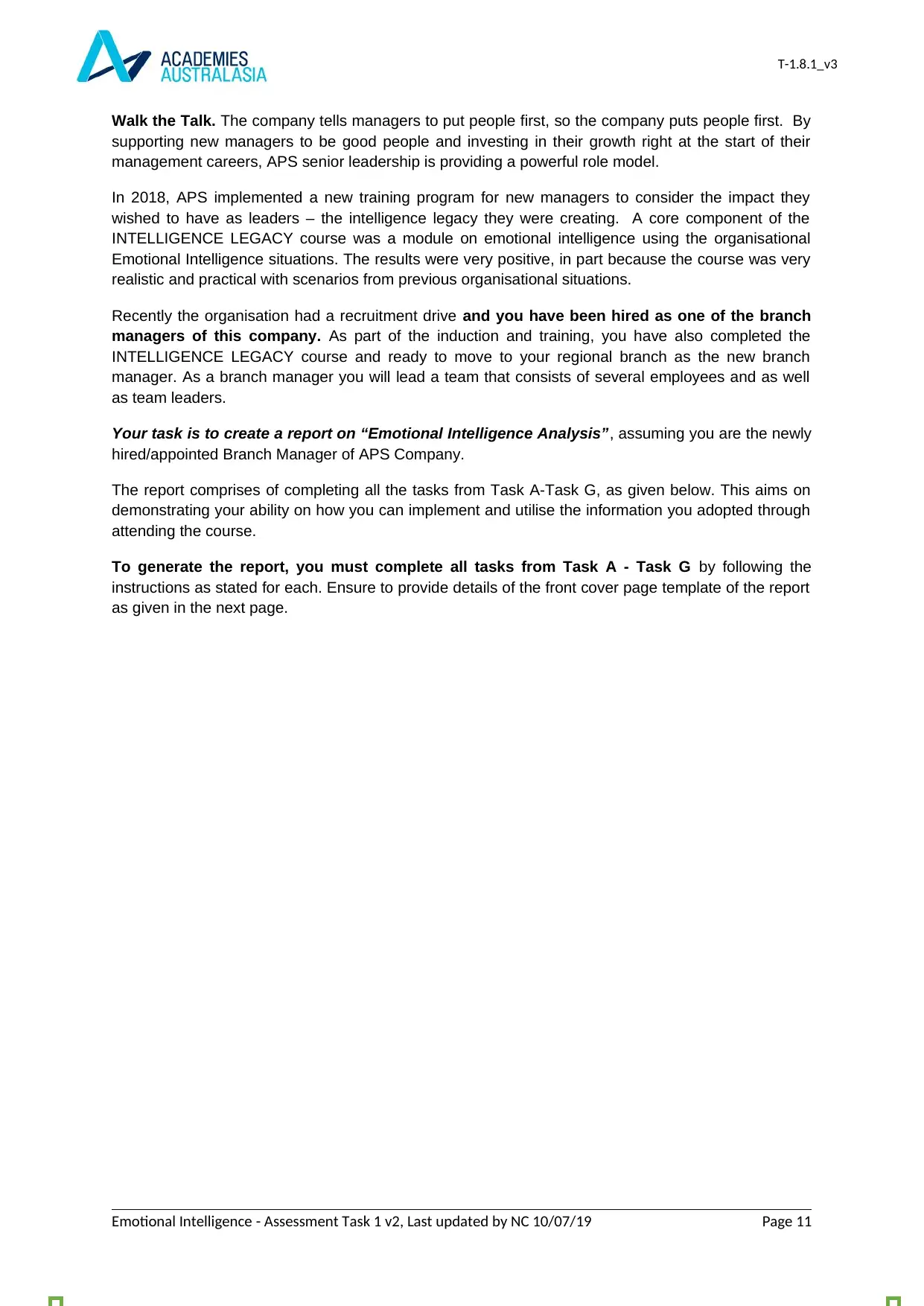
T-1.8.1_v3
Walk the Talk. The company tells managers to put people first, so the company puts people first. By
supporting new managers to be good people and investing in their growth right at the start of their
management careers, APS senior leadership is providing a powerful role model.
In 2018, APS implemented a new training program for new managers to consider the impact they
wished to have as leaders – the intelligence legacy they were creating. A core component of the
INTELLIGENCE LEGACY course was a module on emotional intelligence using the organisational
Emotional Intelligence situations. The results were very positive, in part because the course was very
realistic and practical with scenarios from previous organisational situations.
Recently the organisation had a recruitment drive and you have been hired as one of the branch
managers of this company. As part of the induction and training, you have also completed the
INTELLIGENCE LEGACY course and ready to move to your regional branch as the new branch
manager. As a branch manager you will lead a team that consists of several employees and as well
as team leaders.
Your task is to create a report on “Emotional Intelligence Analysis”, assuming you are the newly
hired/appointed Branch Manager of APS Company.
The report comprises of completing all the tasks from Task A-Task G, as given below. This aims on
demonstrating your ability on how you can implement and utilise the information you adopted through
attending the course.
To generate the report, you must complete all tasks from Task A - Task G by following the
instructions as stated for each. Ensure to provide details of the front cover page template of the report
as given in the next page.
Emotional Intelligence - Assessment Task 1 v2, Last updated by NC 10/07/19 Page 11
Walk the Talk. The company tells managers to put people first, so the company puts people first. By
supporting new managers to be good people and investing in their growth right at the start of their
management careers, APS senior leadership is providing a powerful role model.
In 2018, APS implemented a new training program for new managers to consider the impact they
wished to have as leaders – the intelligence legacy they were creating. A core component of the
INTELLIGENCE LEGACY course was a module on emotional intelligence using the organisational
Emotional Intelligence situations. The results were very positive, in part because the course was very
realistic and practical with scenarios from previous organisational situations.
Recently the organisation had a recruitment drive and you have been hired as one of the branch
managers of this company. As part of the induction and training, you have also completed the
INTELLIGENCE LEGACY course and ready to move to your regional branch as the new branch
manager. As a branch manager you will lead a team that consists of several employees and as well
as team leaders.
Your task is to create a report on “Emotional Intelligence Analysis”, assuming you are the newly
hired/appointed Branch Manager of APS Company.
The report comprises of completing all the tasks from Task A-Task G, as given below. This aims on
demonstrating your ability on how you can implement and utilise the information you adopted through
attending the course.
To generate the report, you must complete all tasks from Task A - Task G by following the
instructions as stated for each. Ensure to provide details of the front cover page template of the report
as given in the next page.
Emotional Intelligence - Assessment Task 1 v2, Last updated by NC 10/07/19 Page 11
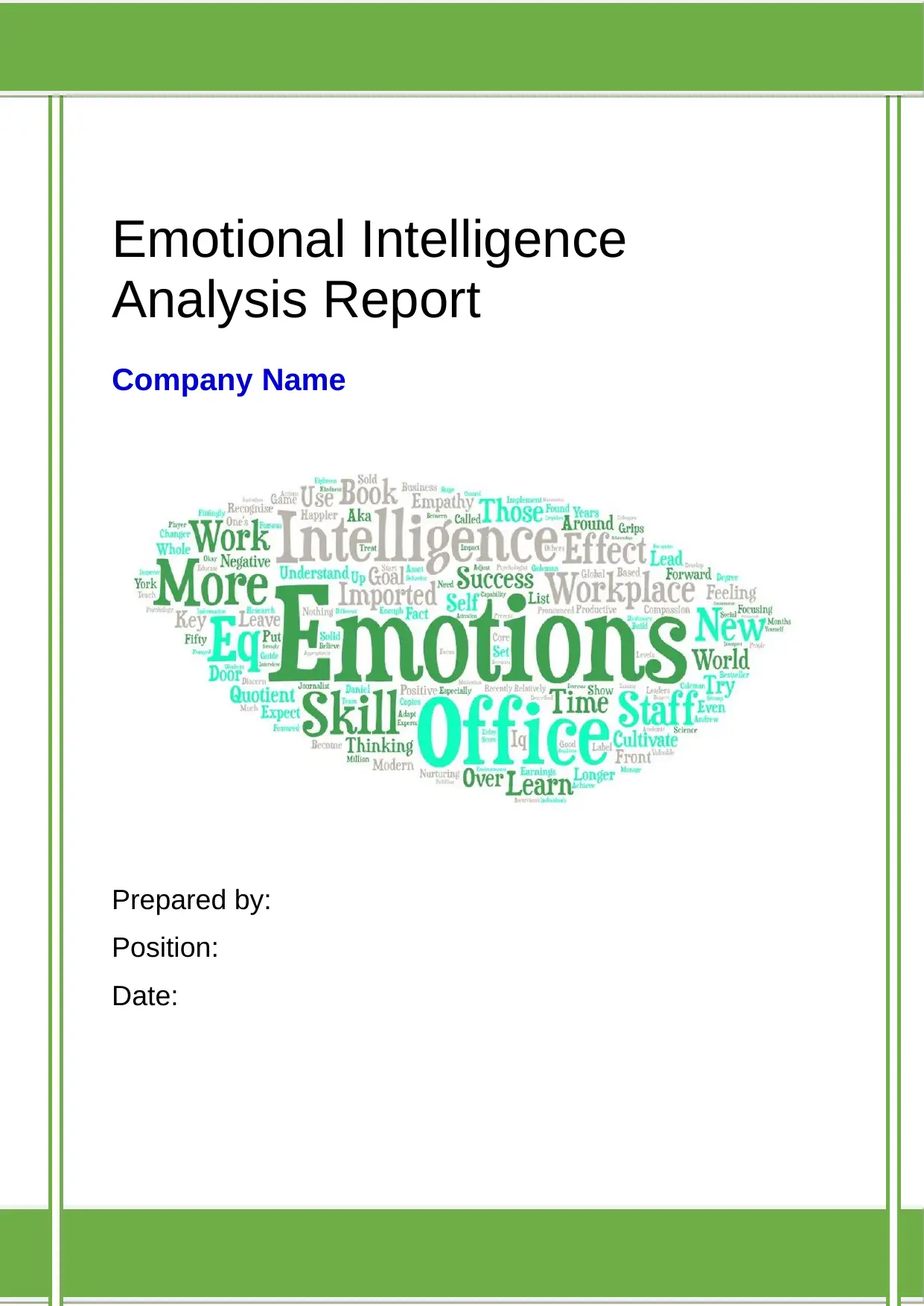
T-1.8.1_v3
Emotional Intelligence
Analysis Report
Company Name
Prepared by:
Position:
Date:
Emotional Intelligence - Assessment Task 1 v2, Last updated by NC 10/07/19 Page 12
Emotional Intelligence
Analysis Report
Company Name
Prepared by:
Position:
Date:
Emotional Intelligence - Assessment Task 1 v2, Last updated by NC 10/07/19 Page 12
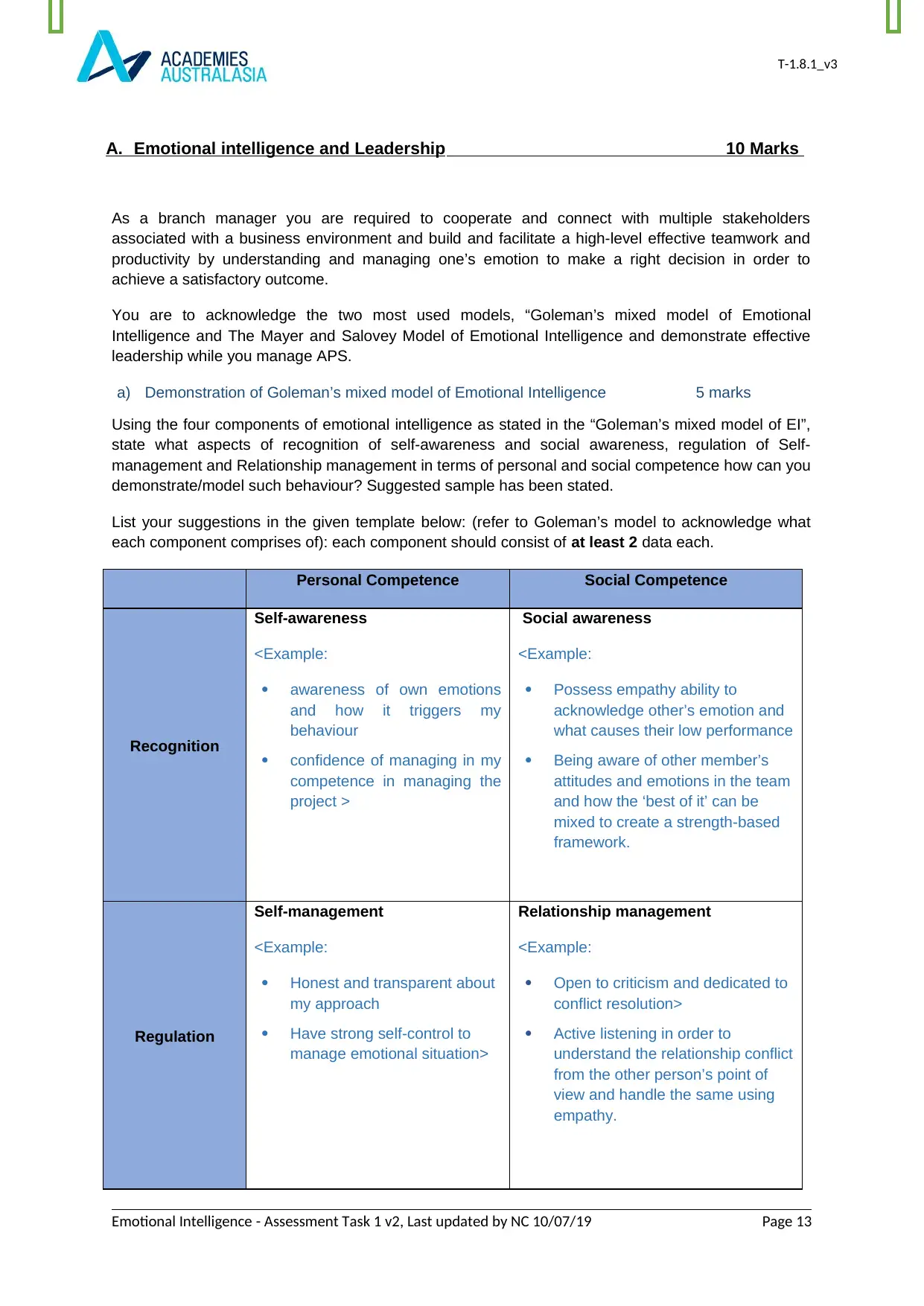
T-1.8.1_v3
A. Emotional intelligence and Leadership 10 Marks
As a branch manager you are required to cooperate and connect with multiple stakeholders
associated with a business environment and build and facilitate a high-level effective teamwork and
productivity by understanding and managing one’s emotion to make a right decision in order to
achieve a satisfactory outcome.
You are to acknowledge the two most used models, “Goleman’s mixed model of Emotional
Intelligence and The Mayer and Salovey Model of Emotional Intelligence and demonstrate effective
leadership while you manage APS.
a) Demonstration of Goleman’s mixed model of Emotional Intelligence 5 marks
Using the four components of emotional intelligence as stated in the “Goleman’s mixed model of EI”,
state what aspects of recognition of self-awareness and social awareness, regulation of Self-
management and Relationship management in terms of personal and social competence how can you
demonstrate/model such behaviour? Suggested sample has been stated.
List your suggestions in the given template below: (refer to Goleman’s model to acknowledge what
each component comprises of): each component should consist of at least 2 data each.
Personal Competence Social Competence
Recognition
Self-awareness
<Example:
awareness of own emotions
and how it triggers my
behaviour
confidence of managing in my
competence in managing the
project >
Social awareness
<Example:
Possess empathy ability to
acknowledge other’s emotion and
what causes their low performance
Being aware of other member’s
attitudes and emotions in the team
and how the ‘best of it’ can be
mixed to create a strength-based
framework.
Regulation
Self-management
<Example:
Honest and transparent about
my approach
Have strong self-control to
manage emotional situation>
Relationship management
<Example:
Open to criticism and dedicated to
conflict resolution>
Active listening in order to
understand the relationship conflict
from the other person’s point of
view and handle the same using
empathy.
Emotional Intelligence - Assessment Task 1 v2, Last updated by NC 10/07/19 Page 13
A. Emotional intelligence and Leadership 10 Marks
As a branch manager you are required to cooperate and connect with multiple stakeholders
associated with a business environment and build and facilitate a high-level effective teamwork and
productivity by understanding and managing one’s emotion to make a right decision in order to
achieve a satisfactory outcome.
You are to acknowledge the two most used models, “Goleman’s mixed model of Emotional
Intelligence and The Mayer and Salovey Model of Emotional Intelligence and demonstrate effective
leadership while you manage APS.
a) Demonstration of Goleman’s mixed model of Emotional Intelligence 5 marks
Using the four components of emotional intelligence as stated in the “Goleman’s mixed model of EI”,
state what aspects of recognition of self-awareness and social awareness, regulation of Self-
management and Relationship management in terms of personal and social competence how can you
demonstrate/model such behaviour? Suggested sample has been stated.
List your suggestions in the given template below: (refer to Goleman’s model to acknowledge what
each component comprises of): each component should consist of at least 2 data each.
Personal Competence Social Competence
Recognition
Self-awareness
<Example:
awareness of own emotions
and how it triggers my
behaviour
confidence of managing in my
competence in managing the
project >
Social awareness
<Example:
Possess empathy ability to
acknowledge other’s emotion and
what causes their low performance
Being aware of other member’s
attitudes and emotions in the team
and how the ‘best of it’ can be
mixed to create a strength-based
framework.
Regulation
Self-management
<Example:
Honest and transparent about
my approach
Have strong self-control to
manage emotional situation>
Relationship management
<Example:
Open to criticism and dedicated to
conflict resolution>
Active listening in order to
understand the relationship conflict
from the other person’s point of
view and handle the same using
empathy.
Emotional Intelligence - Assessment Task 1 v2, Last updated by NC 10/07/19 Page 13
Paraphrase This Document
Need a fresh take? Get an instant paraphrase of this document with our AI Paraphraser
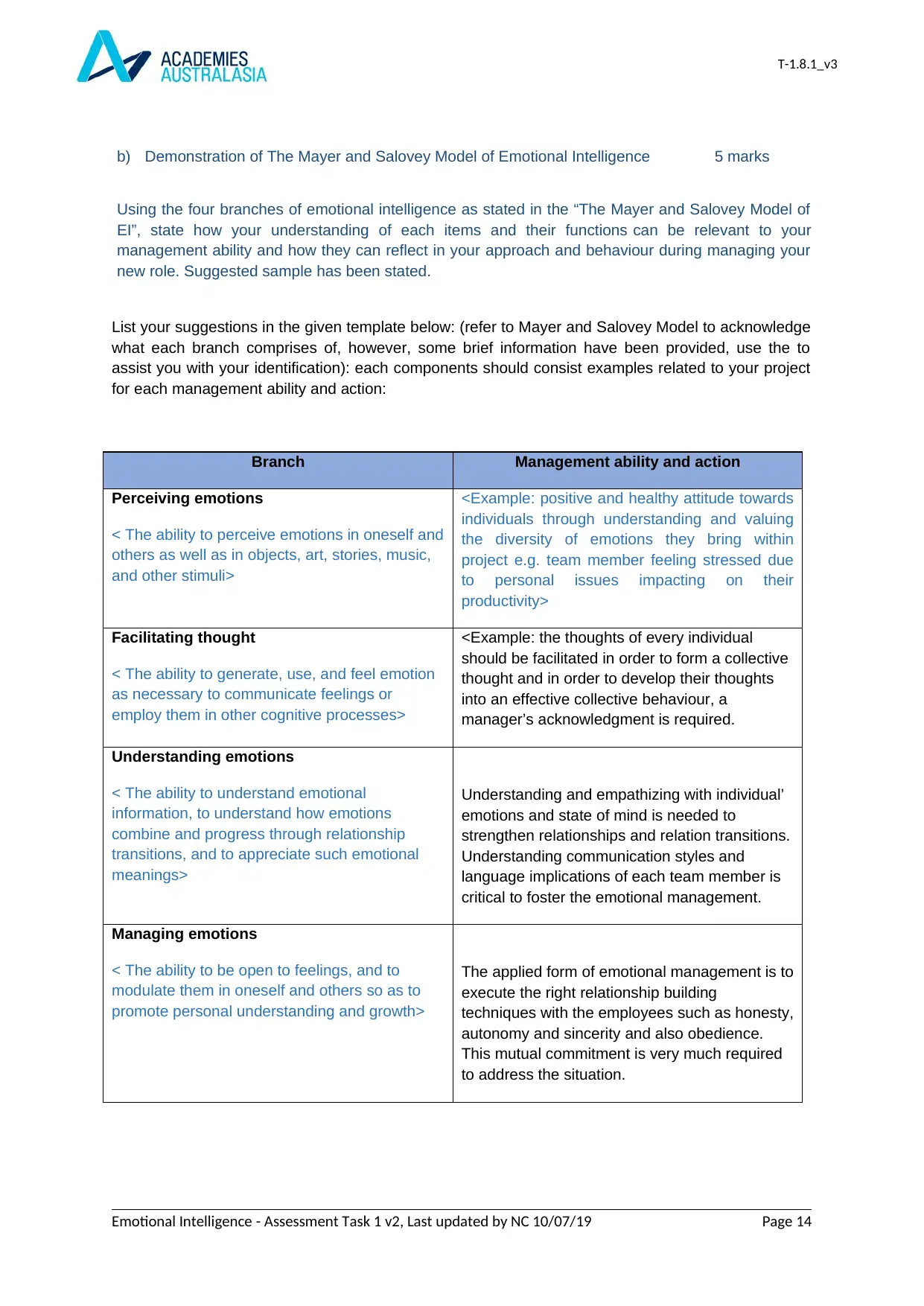
T-1.8.1_v3
b) Demonstration of The Mayer and Salovey Model of Emotional Intelligence 5 marks
Using the four branches of emotional intelligence as stated in the “The Mayer and Salovey Model of
EI”, state how your understanding of each items and their functions can be relevant to your
management ability and how they can reflect in your approach and behaviour during managing your
new role. Suggested sample has been stated.
List your suggestions in the given template below: (refer to Mayer and Salovey Model to acknowledge
what each branch comprises of, however, some brief information have been provided, use the to
assist you with your identification): each components should consist examples related to your project
for each management ability and action:
Branch Management ability and action
Perceiving emotions
< The ability to perceive emotions in oneself and
others as well as in objects, art, stories, music,
and other stimuli>
<Example: positive and healthy attitude towards
individuals through understanding and valuing
the diversity of emotions they bring within
project e.g. team member feeling stressed due
to personal issues impacting on their
productivity>
Facilitating thought
< The ability to generate, use, and feel emotion
as necessary to communicate feelings or
employ them in other cognitive processes>
<Example: the thoughts of every individual
should be facilitated in order to form a collective
thought and in order to develop their thoughts
into an effective collective behaviour, a
manager’s acknowledgment is required.
Understanding emotions
< The ability to understand emotional
information, to understand how emotions
combine and progress through relationship
transitions, and to appreciate such emotional
meanings>
Understanding and empathizing with individual’
emotions and state of mind is needed to
strengthen relationships and relation transitions.
Understanding communication styles and
language implications of each team member is
critical to foster the emotional management.
Managing emotions
< The ability to be open to feelings, and to
modulate them in oneself and others so as to
promote personal understanding and growth>
The applied form of emotional management is to
execute the right relationship building
techniques with the employees such as honesty,
autonomy and sincerity and also obedience.
This mutual commitment is very much required
to address the situation.
Emotional Intelligence - Assessment Task 1 v2, Last updated by NC 10/07/19 Page 14
b) Demonstration of The Mayer and Salovey Model of Emotional Intelligence 5 marks
Using the four branches of emotional intelligence as stated in the “The Mayer and Salovey Model of
EI”, state how your understanding of each items and their functions can be relevant to your
management ability and how they can reflect in your approach and behaviour during managing your
new role. Suggested sample has been stated.
List your suggestions in the given template below: (refer to Mayer and Salovey Model to acknowledge
what each branch comprises of, however, some brief information have been provided, use the to
assist you with your identification): each components should consist examples related to your project
for each management ability and action:
Branch Management ability and action
Perceiving emotions
< The ability to perceive emotions in oneself and
others as well as in objects, art, stories, music,
and other stimuli>
<Example: positive and healthy attitude towards
individuals through understanding and valuing
the diversity of emotions they bring within
project e.g. team member feeling stressed due
to personal issues impacting on their
productivity>
Facilitating thought
< The ability to generate, use, and feel emotion
as necessary to communicate feelings or
employ them in other cognitive processes>
<Example: the thoughts of every individual
should be facilitated in order to form a collective
thought and in order to develop their thoughts
into an effective collective behaviour, a
manager’s acknowledgment is required.
Understanding emotions
< The ability to understand emotional
information, to understand how emotions
combine and progress through relationship
transitions, and to appreciate such emotional
meanings>
Understanding and empathizing with individual’
emotions and state of mind is needed to
strengthen relationships and relation transitions.
Understanding communication styles and
language implications of each team member is
critical to foster the emotional management.
Managing emotions
< The ability to be open to feelings, and to
modulate them in oneself and others so as to
promote personal understanding and growth>
The applied form of emotional management is to
execute the right relationship building
techniques with the employees such as honesty,
autonomy and sincerity and also obedience.
This mutual commitment is very much required
to address the situation.
Emotional Intelligence - Assessment Task 1 v2, Last updated by NC 10/07/19 Page 14
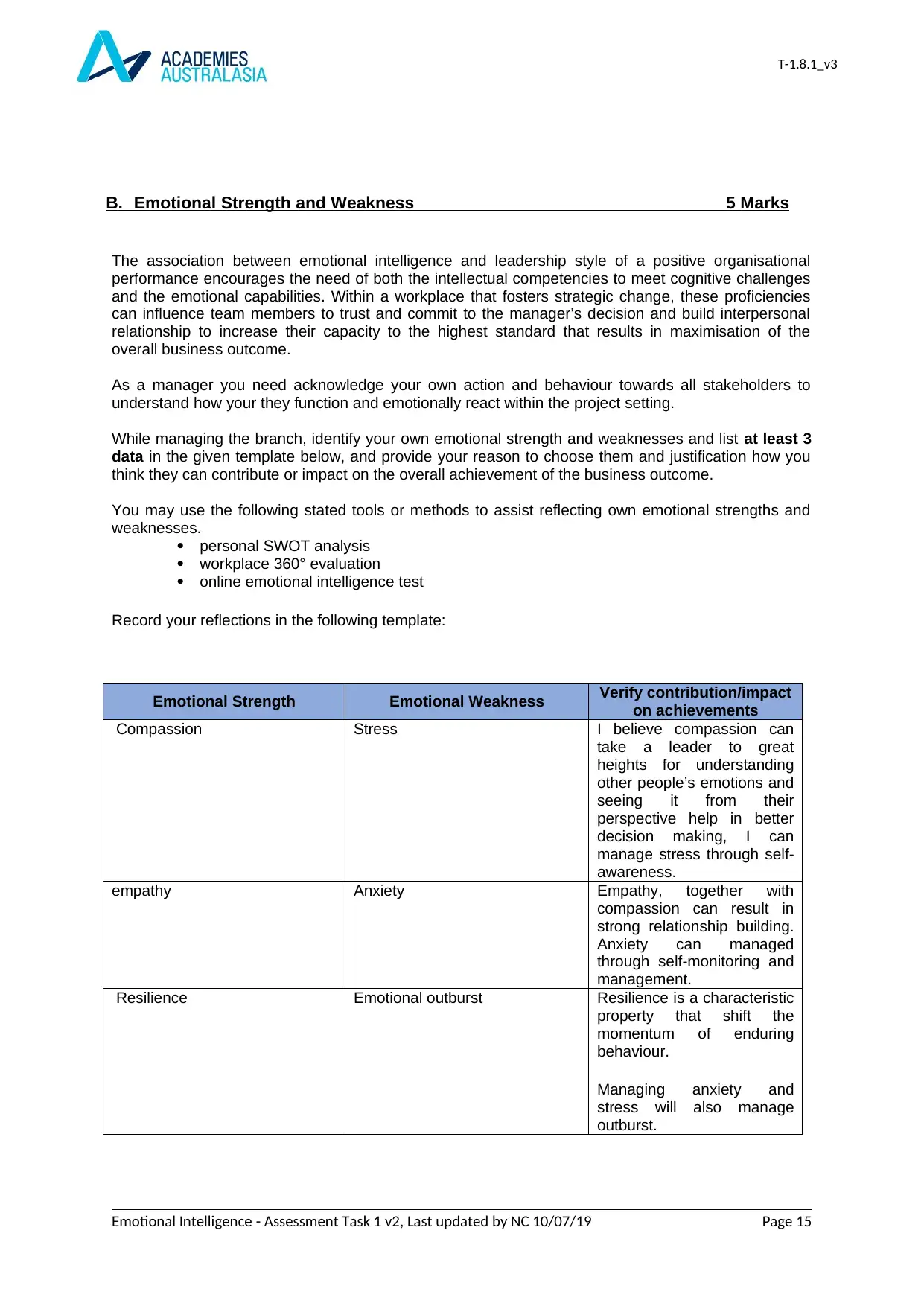
T-1.8.1_v3
B. Emotional Strength and Weakness 5 Marks
The association between emotional intelligence and leadership style of a positive organisational
performance encourages the need of both the intellectual competencies to meet cognitive challenges
and the emotional capabilities. Within a workplace that fosters strategic change, these proficiencies
can influence team members to trust and commit to the manager’s decision and build interpersonal
relationship to increase their capacity to the highest standard that results in maximisation of the
overall business outcome.
As a manager you need acknowledge your own action and behaviour towards all stakeholders to
understand how your they function and emotionally react within the project setting.
While managing the branch, identify your own emotional strength and weaknesses and list at least 3
data in the given template below, and provide your reason to choose them and justification how you
think they can contribute or impact on the overall achievement of the business outcome.
You may use the following stated tools or methods to assist reflecting own emotional strengths and
weaknesses.
personal SWOT analysis
workplace 360° evaluation
online emotional intelligence test
Record your reflections in the following template:
Emotional Strength Emotional Weakness Verify contribution/impact
on achievements
Compassion Stress I believe compassion can
take a leader to great
heights for understanding
other people’s emotions and
seeing it from their
perspective help in better
decision making, I can
manage stress through self-
awareness.
empathy Anxiety Empathy, together with
compassion can result in
strong relationship building.
Anxiety can managed
through self-monitoring and
management.
Resilience Emotional outburst Resilience is a characteristic
property that shift the
momentum of enduring
behaviour.
Managing anxiety and
stress will also manage
outburst.
Emotional Intelligence - Assessment Task 1 v2, Last updated by NC 10/07/19 Page 15
B. Emotional Strength and Weakness 5 Marks
The association between emotional intelligence and leadership style of a positive organisational
performance encourages the need of both the intellectual competencies to meet cognitive challenges
and the emotional capabilities. Within a workplace that fosters strategic change, these proficiencies
can influence team members to trust and commit to the manager’s decision and build interpersonal
relationship to increase their capacity to the highest standard that results in maximisation of the
overall business outcome.
As a manager you need acknowledge your own action and behaviour towards all stakeholders to
understand how your they function and emotionally react within the project setting.
While managing the branch, identify your own emotional strength and weaknesses and list at least 3
data in the given template below, and provide your reason to choose them and justification how you
think they can contribute or impact on the overall achievement of the business outcome.
You may use the following stated tools or methods to assist reflecting own emotional strengths and
weaknesses.
personal SWOT analysis
workplace 360° evaluation
online emotional intelligence test
Record your reflections in the following template:
Emotional Strength Emotional Weakness Verify contribution/impact
on achievements
Compassion Stress I believe compassion can
take a leader to great
heights for understanding
other people’s emotions and
seeing it from their
perspective help in better
decision making, I can
manage stress through self-
awareness.
empathy Anxiety Empathy, together with
compassion can result in
strong relationship building.
Anxiety can managed
through self-monitoring and
management.
Resilience Emotional outburst Resilience is a characteristic
property that shift the
momentum of enduring
behaviour.
Managing anxiety and
stress will also manage
outburst.
Emotional Intelligence - Assessment Task 1 v2, Last updated by NC 10/07/19 Page 15
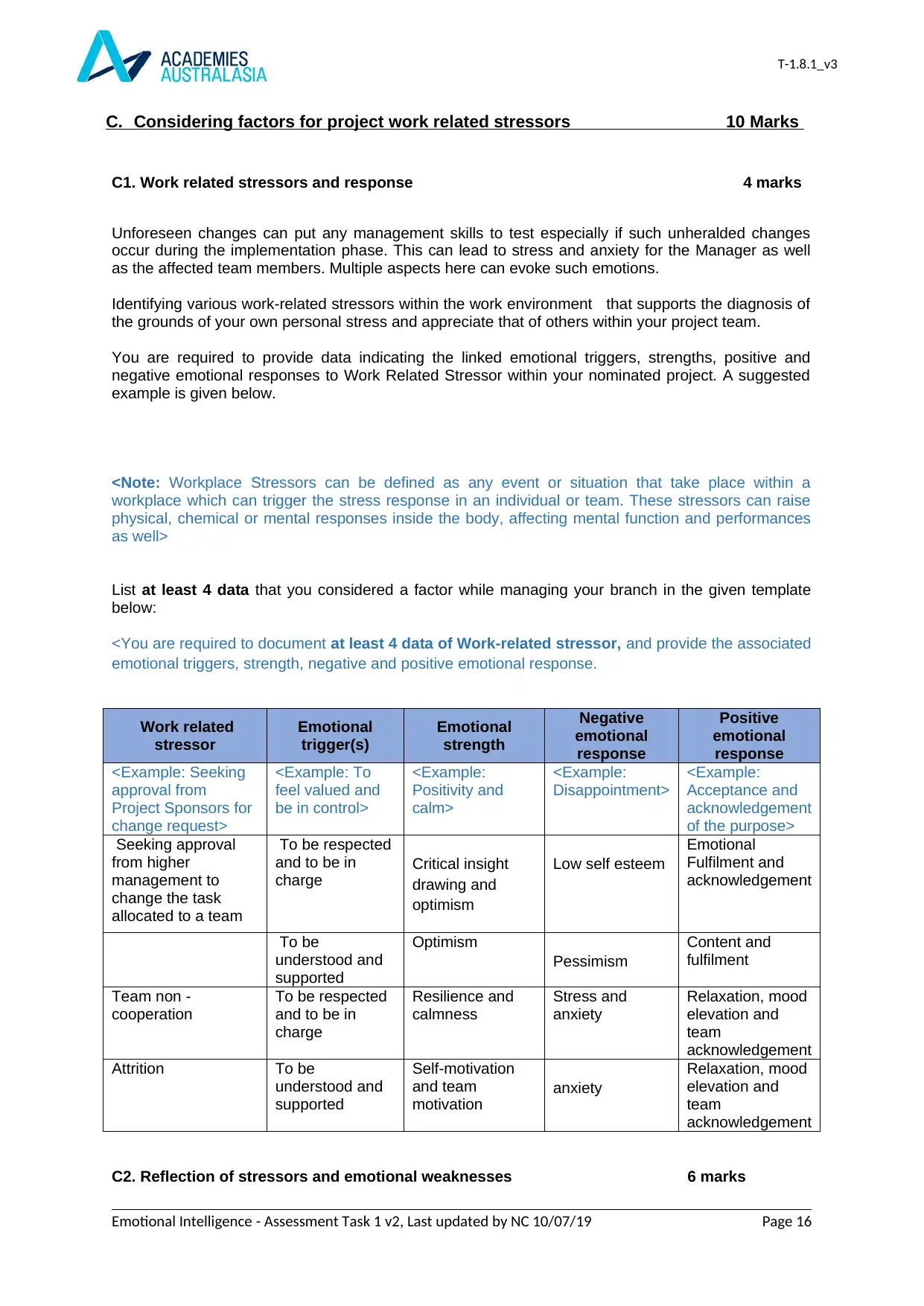
T-1.8.1_v3
C. Considering factors for project work related stressors 10 Marks
C1. Work related stressors and response 4 marks
Unforeseen changes can put any management skills to test especially if such unheralded changes
occur during the implementation phase. This can lead to stress and anxiety for the Manager as well
as the affected team members. Multiple aspects here can evoke such emotions.
Identifying various work-related stressors within the work environment that supports the diagnosis of
the grounds of your own personal stress and appreciate that of others within your project team.
You are required to provide data indicating the linked emotional triggers, strengths, positive and
negative emotional responses to Work Related Stressor within your nominated project. A suggested
example is given below.
<Note: Workplace Stressors can be defined as any event or situation that take place within a
workplace which can trigger the stress response in an individual or team. These stressors can raise
physical, chemical or mental responses inside the body, affecting mental function and performances
as well>
List at least 4 data that you considered a factor while managing your branch in the given template
below:
<You are required to document at least 4 data of Work-related stressor, and provide the associated
emotional triggers, strength, negative and positive emotional response.
Work related
stressor
Emotional
trigger(s)
Emotional
strength
Negative
emotional
response
Positive
emotional
response
<Example: Seeking
approval from
Project Sponsors for
change request>
<Example: To
feel valued and
be in control>
<Example:
Positivity and
calm>
<Example:
Disappointment>
<Example:
Acceptance and
acknowledgement
of the purpose>
Seeking approval
from higher
management to
change the task
allocated to a team
To be respected
and to be in
charge
Critical insight
drawing and
optimism
Low self esteem
Emotional
Fulfilment and
acknowledgement
To be
understood and
supported
Optimism
Pessimism
Content and
fulfilment
Team non -
cooperation
To be respected
and to be in
charge
Resilience and
calmness
Stress and
anxiety
Relaxation, mood
elevation and
team
acknowledgement
Attrition To be
understood and
supported
Self-motivation
and team
motivation
anxiety
Relaxation, mood
elevation and
team
acknowledgement
C2. Reflection of stressors and emotional weaknesses 6 marks
Emotional Intelligence - Assessment Task 1 v2, Last updated by NC 10/07/19 Page 16
C. Considering factors for project work related stressors 10 Marks
C1. Work related stressors and response 4 marks
Unforeseen changes can put any management skills to test especially if such unheralded changes
occur during the implementation phase. This can lead to stress and anxiety for the Manager as well
as the affected team members. Multiple aspects here can evoke such emotions.
Identifying various work-related stressors within the work environment that supports the diagnosis of
the grounds of your own personal stress and appreciate that of others within your project team.
You are required to provide data indicating the linked emotional triggers, strengths, positive and
negative emotional responses to Work Related Stressor within your nominated project. A suggested
example is given below.
<Note: Workplace Stressors can be defined as any event or situation that take place within a
workplace which can trigger the stress response in an individual or team. These stressors can raise
physical, chemical or mental responses inside the body, affecting mental function and performances
as well>
List at least 4 data that you considered a factor while managing your branch in the given template
below:
<You are required to document at least 4 data of Work-related stressor, and provide the associated
emotional triggers, strength, negative and positive emotional response.
Work related
stressor
Emotional
trigger(s)
Emotional
strength
Negative
emotional
response
Positive
emotional
response
<Example: Seeking
approval from
Project Sponsors for
change request>
<Example: To
feel valued and
be in control>
<Example:
Positivity and
calm>
<Example:
Disappointment>
<Example:
Acceptance and
acknowledgement
of the purpose>
Seeking approval
from higher
management to
change the task
allocated to a team
To be respected
and to be in
charge
Critical insight
drawing and
optimism
Low self esteem
Emotional
Fulfilment and
acknowledgement
To be
understood and
supported
Optimism
Pessimism
Content and
fulfilment
Team non -
cooperation
To be respected
and to be in
charge
Resilience and
calmness
Stress and
anxiety
Relaxation, mood
elevation and
team
acknowledgement
Attrition To be
understood and
supported
Self-motivation
and team
motivation
anxiety
Relaxation, mood
elevation and
team
acknowledgement
C2. Reflection of stressors and emotional weaknesses 6 marks
Emotional Intelligence - Assessment Task 1 v2, Last updated by NC 10/07/19 Page 16
Secure Best Marks with AI Grader
Need help grading? Try our AI Grader for instant feedback on your assignments.
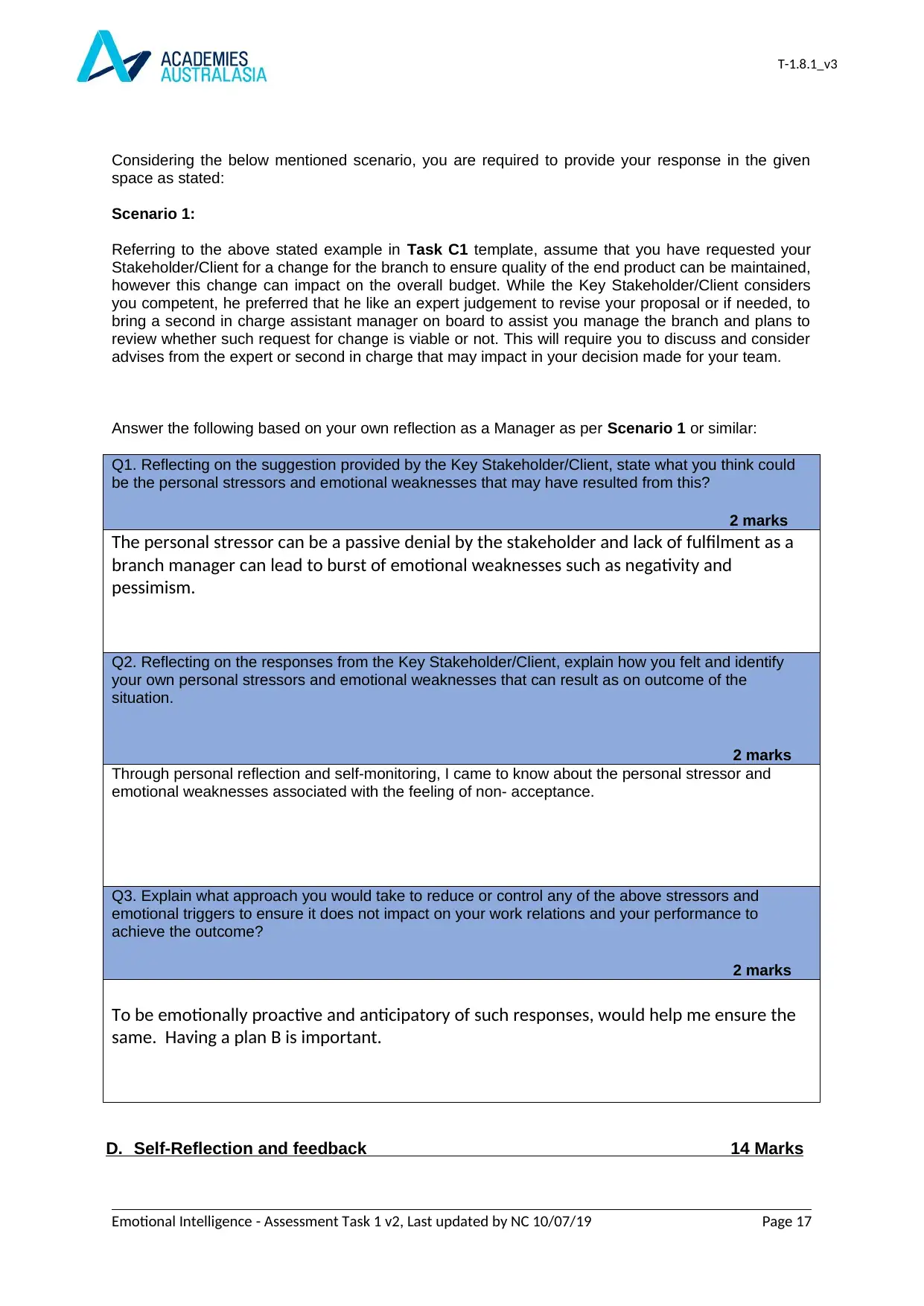
T-1.8.1_v3
Considering the below mentioned scenario, you are required to provide your response in the given
space as stated:
Scenario 1:
Referring to the above stated example in Task C1 template, assume that you have requested your
Stakeholder/Client for a change for the branch to ensure quality of the end product can be maintained,
however this change can impact on the overall budget. While the Key Stakeholder/Client considers
you competent, he preferred that he like an expert judgement to revise your proposal or if needed, to
bring a second in charge assistant manager on board to assist you manage the branch and plans to
review whether such request for change is viable or not. This will require you to discuss and consider
advises from the expert or second in charge that may impact in your decision made for your team.
Answer the following based on your own reflection as a Manager as per Scenario 1 or similar:
Q1. Reflecting on the suggestion provided by the Key Stakeholder/Client, state what you think could
be the personal stressors and emotional weaknesses that may have resulted from this?
2 marks
The personal stressor can be a passive denial by the stakeholder and lack of fulfilment as a
branch manager can lead to burst of emotional weaknesses such as negativity and
pessimism.
Q2. Reflecting on the responses from the Key Stakeholder/Client, explain how you felt and identify
your own personal stressors and emotional weaknesses that can result as on outcome of the
situation.
2 marks
Through personal reflection and self-monitoring, I came to know about the personal stressor and
emotional weaknesses associated with the feeling of non- acceptance.
Q3. Explain what approach you would take to reduce or control any of the above stressors and
emotional triggers to ensure it does not impact on your work relations and your performance to
achieve the outcome?
2 marks
To be emotionally proactive and anticipatory of such responses, would help me ensure the
same. Having a plan B is important.
D. Self-Reflection and feedback 14 Marks
Emotional Intelligence - Assessment Task 1 v2, Last updated by NC 10/07/19 Page 17
Considering the below mentioned scenario, you are required to provide your response in the given
space as stated:
Scenario 1:
Referring to the above stated example in Task C1 template, assume that you have requested your
Stakeholder/Client for a change for the branch to ensure quality of the end product can be maintained,
however this change can impact on the overall budget. While the Key Stakeholder/Client considers
you competent, he preferred that he like an expert judgement to revise your proposal or if needed, to
bring a second in charge assistant manager on board to assist you manage the branch and plans to
review whether such request for change is viable or not. This will require you to discuss and consider
advises from the expert or second in charge that may impact in your decision made for your team.
Answer the following based on your own reflection as a Manager as per Scenario 1 or similar:
Q1. Reflecting on the suggestion provided by the Key Stakeholder/Client, state what you think could
be the personal stressors and emotional weaknesses that may have resulted from this?
2 marks
The personal stressor can be a passive denial by the stakeholder and lack of fulfilment as a
branch manager can lead to burst of emotional weaknesses such as negativity and
pessimism.
Q2. Reflecting on the responses from the Key Stakeholder/Client, explain how you felt and identify
your own personal stressors and emotional weaknesses that can result as on outcome of the
situation.
2 marks
Through personal reflection and self-monitoring, I came to know about the personal stressor and
emotional weaknesses associated with the feeling of non- acceptance.
Q3. Explain what approach you would take to reduce or control any of the above stressors and
emotional triggers to ensure it does not impact on your work relations and your performance to
achieve the outcome?
2 marks
To be emotionally proactive and anticipatory of such responses, would help me ensure the
same. Having a plan B is important.
D. Self-Reflection and feedback 14 Marks
Emotional Intelligence - Assessment Task 1 v2, Last updated by NC 10/07/19 Page 17
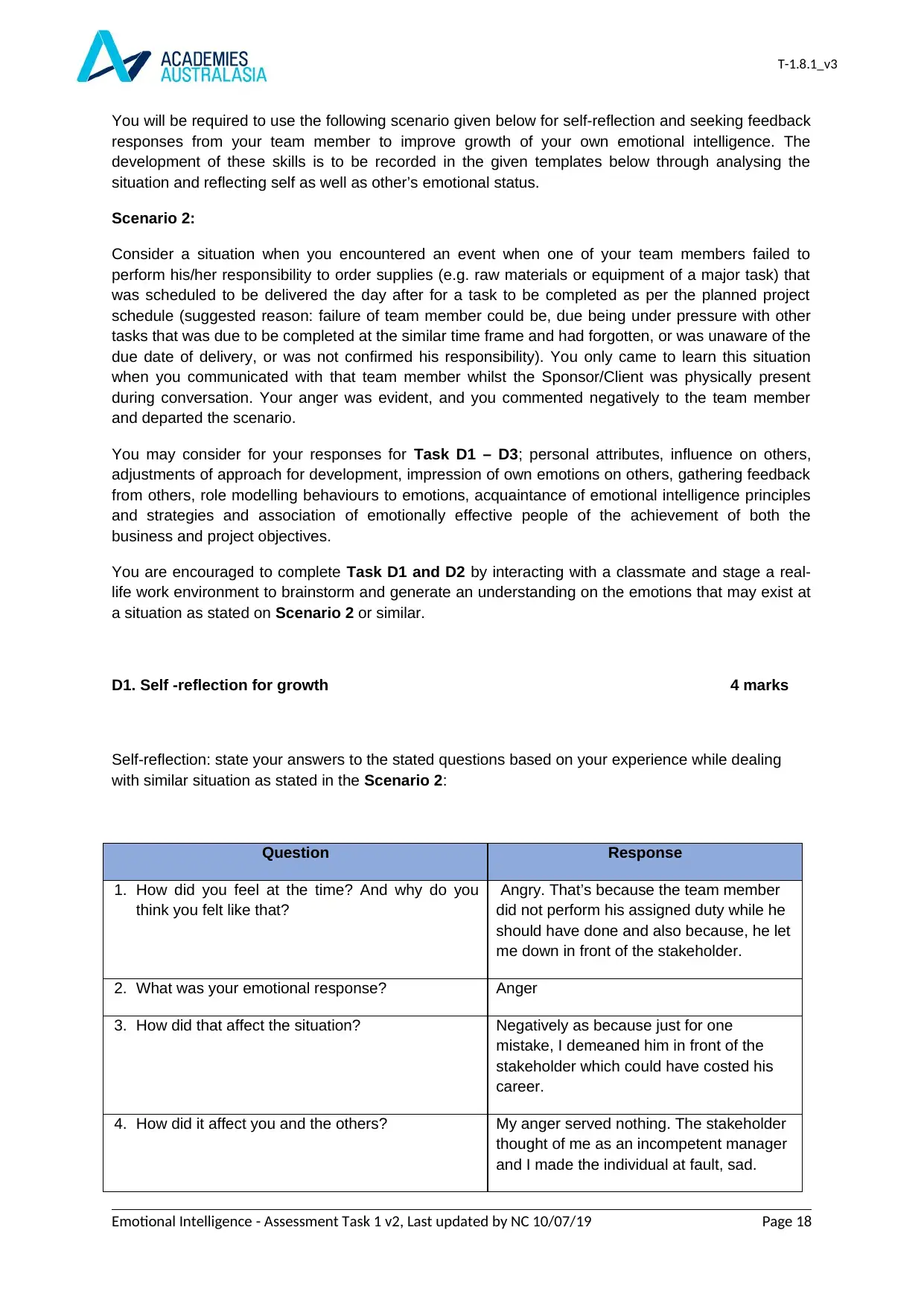
T-1.8.1_v3
You will be required to use the following scenario given below for self-reflection and seeking feedback
responses from your team member to improve growth of your own emotional intelligence. The
development of these skills is to be recorded in the given templates below through analysing the
situation and reflecting self as well as other’s emotional status.
Scenario 2:
Consider a situation when you encountered an event when one of your team members failed to
perform his/her responsibility to order supplies (e.g. raw materials or equipment of a major task) that
was scheduled to be delivered the day after for a task to be completed as per the planned project
schedule (suggested reason: failure of team member could be, due being under pressure with other
tasks that was due to be completed at the similar time frame and had forgotten, or was unaware of the
due date of delivery, or was not confirmed his responsibility). You only came to learn this situation
when you communicated with that team member whilst the Sponsor/Client was physically present
during conversation. Your anger was evident, and you commented negatively to the team member
and departed the scenario.
You may consider for your responses for Task D1 – D3; personal attributes, influence on others,
adjustments of approach for development, impression of own emotions on others, gathering feedback
from others, role modelling behaviours to emotions, acquaintance of emotional intelligence principles
and strategies and association of emotionally effective people of the achievement of both the
business and project objectives.
You are encouraged to complete Task D1 and D2 by interacting with a classmate and stage a real-
life work environment to brainstorm and generate an understanding on the emotions that may exist at
a situation as stated on Scenario 2 or similar.
D1. Self -reflection for growth 4 marks
Self-reflection: state your answers to the stated questions based on your experience while dealing
with similar situation as stated in the Scenario 2:
Question Response
1. How did you feel at the time? And why do you
think you felt like that?
Angry. That’s because the team member
did not perform his assigned duty while he
should have done and also because, he let
me down in front of the stakeholder.
2. What was your emotional response? Anger
3. How did that affect the situation? Negatively as because just for one
mistake, I demeaned him in front of the
stakeholder which could have costed his
career.
4. How did it affect you and the others? My anger served nothing. The stakeholder
thought of me as an incompetent manager
and I made the individual at fault, sad.
Emotional Intelligence - Assessment Task 1 v2, Last updated by NC 10/07/19 Page 18
You will be required to use the following scenario given below for self-reflection and seeking feedback
responses from your team member to improve growth of your own emotional intelligence. The
development of these skills is to be recorded in the given templates below through analysing the
situation and reflecting self as well as other’s emotional status.
Scenario 2:
Consider a situation when you encountered an event when one of your team members failed to
perform his/her responsibility to order supplies (e.g. raw materials or equipment of a major task) that
was scheduled to be delivered the day after for a task to be completed as per the planned project
schedule (suggested reason: failure of team member could be, due being under pressure with other
tasks that was due to be completed at the similar time frame and had forgotten, or was unaware of the
due date of delivery, or was not confirmed his responsibility). You only came to learn this situation
when you communicated with that team member whilst the Sponsor/Client was physically present
during conversation. Your anger was evident, and you commented negatively to the team member
and departed the scenario.
You may consider for your responses for Task D1 – D3; personal attributes, influence on others,
adjustments of approach for development, impression of own emotions on others, gathering feedback
from others, role modelling behaviours to emotions, acquaintance of emotional intelligence principles
and strategies and association of emotionally effective people of the achievement of both the
business and project objectives.
You are encouraged to complete Task D1 and D2 by interacting with a classmate and stage a real-
life work environment to brainstorm and generate an understanding on the emotions that may exist at
a situation as stated on Scenario 2 or similar.
D1. Self -reflection for growth 4 marks
Self-reflection: state your answers to the stated questions based on your experience while dealing
with similar situation as stated in the Scenario 2:
Question Response
1. How did you feel at the time? And why do you
think you felt like that?
Angry. That’s because the team member
did not perform his assigned duty while he
should have done and also because, he let
me down in front of the stakeholder.
2. What was your emotional response? Anger
3. How did that affect the situation? Negatively as because just for one
mistake, I demeaned him in front of the
stakeholder which could have costed his
career.
4. How did it affect you and the others? My anger served nothing. The stakeholder
thought of me as an incompetent manager
and I made the individual at fault, sad.
Emotional Intelligence - Assessment Task 1 v2, Last updated by NC 10/07/19 Page 18
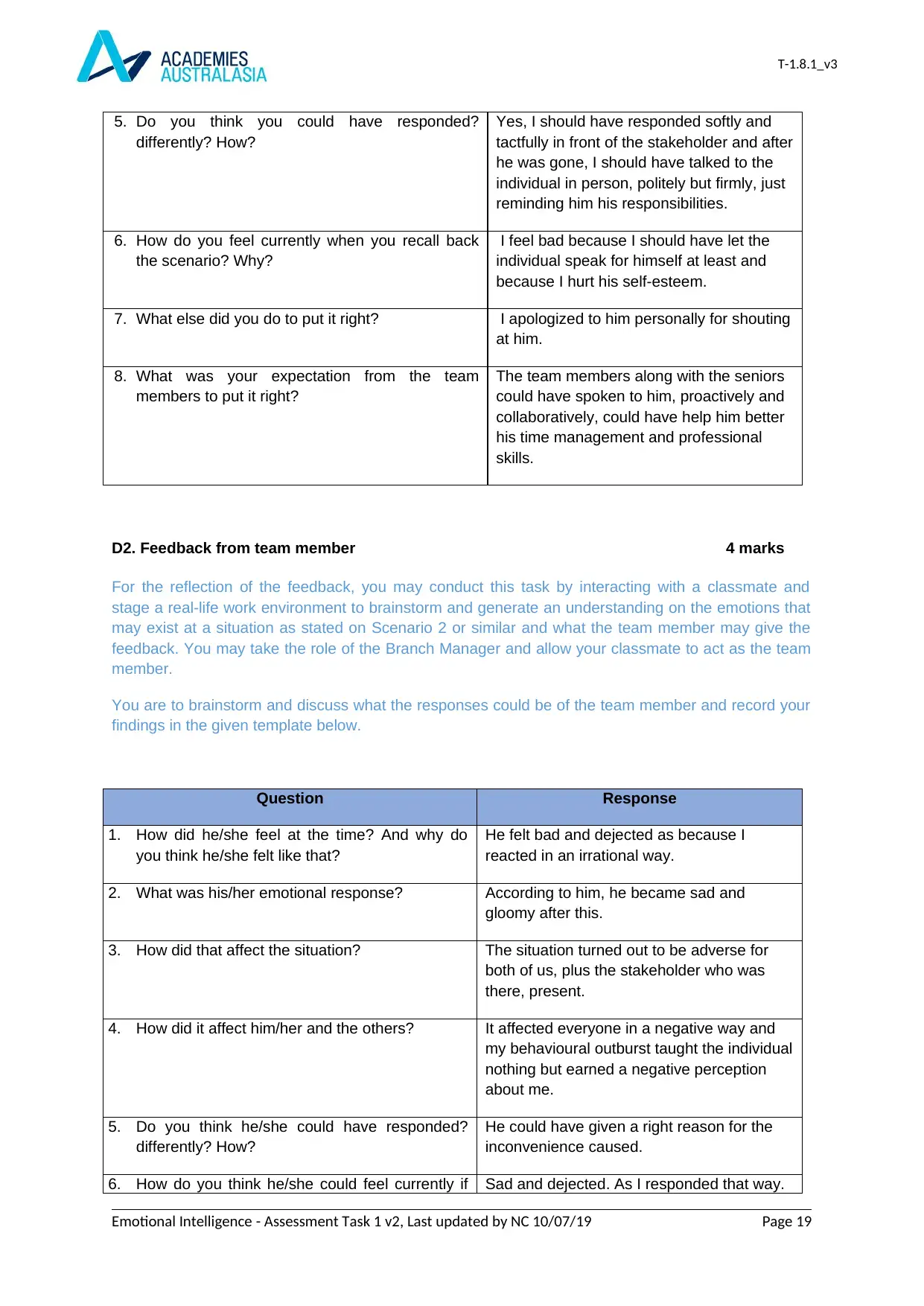
T-1.8.1_v3
5. Do you think you could have responded?
differently? How?
Yes, I should have responded softly and
tactfully in front of the stakeholder and after
he was gone, I should have talked to the
individual in person, politely but firmly, just
reminding him his responsibilities.
6. How do you feel currently when you recall back
the scenario? Why?
I feel bad because I should have let the
individual speak for himself at least and
because I hurt his self-esteem.
7. What else did you do to put it right? I apologized to him personally for shouting
at him.
8. What was your expectation from the team
members to put it right?
The team members along with the seniors
could have spoken to him, proactively and
collaboratively, could have help him better
his time management and professional
skills.
D2. Feedback from team member 4 marks
For the reflection of the feedback, you may conduct this task by interacting with a classmate and
stage a real-life work environment to brainstorm and generate an understanding on the emotions that
may exist at a situation as stated on Scenario 2 or similar and what the team member may give the
feedback. You may take the role of the Branch Manager and allow your classmate to act as the team
member.
You are to brainstorm and discuss what the responses could be of the team member and record your
findings in the given template below.
Question Response
1. How did he/she feel at the time? And why do
you think he/she felt like that?
He felt bad and dejected as because I
reacted in an irrational way.
2. What was his/her emotional response? According to him, he became sad and
gloomy after this.
3. How did that affect the situation? The situation turned out to be adverse for
both of us, plus the stakeholder who was
there, present.
4. How did it affect him/her and the others? It affected everyone in a negative way and
my behavioural outburst taught the individual
nothing but earned a negative perception
about me.
5. Do you think he/she could have responded?
differently? How?
He could have given a right reason for the
inconvenience caused.
6. How do you think he/she could feel currently if Sad and dejected. As I responded that way.
Emotional Intelligence - Assessment Task 1 v2, Last updated by NC 10/07/19 Page 19
5. Do you think you could have responded?
differently? How?
Yes, I should have responded softly and
tactfully in front of the stakeholder and after
he was gone, I should have talked to the
individual in person, politely but firmly, just
reminding him his responsibilities.
6. How do you feel currently when you recall back
the scenario? Why?
I feel bad because I should have let the
individual speak for himself at least and
because I hurt his self-esteem.
7. What else did you do to put it right? I apologized to him personally for shouting
at him.
8. What was your expectation from the team
members to put it right?
The team members along with the seniors
could have spoken to him, proactively and
collaboratively, could have help him better
his time management and professional
skills.
D2. Feedback from team member 4 marks
For the reflection of the feedback, you may conduct this task by interacting with a classmate and
stage a real-life work environment to brainstorm and generate an understanding on the emotions that
may exist at a situation as stated on Scenario 2 or similar and what the team member may give the
feedback. You may take the role of the Branch Manager and allow your classmate to act as the team
member.
You are to brainstorm and discuss what the responses could be of the team member and record your
findings in the given template below.
Question Response
1. How did he/she feel at the time? And why do
you think he/she felt like that?
He felt bad and dejected as because I
reacted in an irrational way.
2. What was his/her emotional response? According to him, he became sad and
gloomy after this.
3. How did that affect the situation? The situation turned out to be adverse for
both of us, plus the stakeholder who was
there, present.
4. How did it affect him/her and the others? It affected everyone in a negative way and
my behavioural outburst taught the individual
nothing but earned a negative perception
about me.
5. Do you think he/she could have responded?
differently? How?
He could have given a right reason for the
inconvenience caused.
6. How do you think he/she could feel currently if Sad and dejected. As I responded that way.
Emotional Intelligence - Assessment Task 1 v2, Last updated by NC 10/07/19 Page 19
Paraphrase This Document
Need a fresh take? Get an instant paraphrase of this document with our AI Paraphraser

T-1.8.1_v3
he/she recalls back the scenario? Why?
7. What else did he/she could do to put it right? Talk to him and apologize.
8. What do you think was his/her expectation from
the Project Manager to put it right?
He might expect the manager to hear him
out and act rationally then. He might expect
a better emotional response.
D3. Actions to improved Emotional intelligence 6 marks
As a Manager, you should establish certain feedback to generate dispute resolution, both in formal
and informal structure that is fair and open and that aligns with the project/organisational policies and
procedures.
Considering the various ways to elicit feedback (e.g. 360 degrees feedback), state at least three (3)
actions that you took to improve your own emotional intelligence on the basis of the self-reflection
and feedback from the team member, as stated in Task D2. Contemplate emotional intelligence
principles and strategies to justify your proposed actions.
List at least three (3) data and record your findings in the given template below:
<You are required to document at least 3 data of actions and associated improvement information
Actions Improvement your own emotional
intelligence
To improve self awareness By meditation, by self-monitoring how I get
affected and how I affect by and the situations,
respectively.
To improve self-management By reflection, keep keeping the moral values
and EI values of my organisation intact.
To improve social awareness By being more responsive as a manager, by
using a more compassionate approach and by
being more oriented to the presenting situations.
E. Cultural Expressions and positive emotional climate 15 Marks
E1. Adapting to Cultural expressions 8 marks
In relation to Task E1, decisions made, when dealing with the emotions with the project workplace
you need to allow your team members to share their views without any judgment or disdain to create
a sense of belonging. Application of good listening techniques to their apprehension support
upholding their high morale. However, it must not be dismissed that not every individual can be
confident to express and so Project managers must become aware of these forms of diversity and
support them by identifying any personal barriers to acceptance.
A Manager should also be flexible to accustom any encounters and be prompting to fine-tune
organisational change and be open in own thinking process to innovative tactics.
Emotional Intelligence - Assessment Task 1 v2, Last updated by NC 10/07/19 Page 20
he/she recalls back the scenario? Why?
7. What else did he/she could do to put it right? Talk to him and apologize.
8. What do you think was his/her expectation from
the Project Manager to put it right?
He might expect the manager to hear him
out and act rationally then. He might expect
a better emotional response.
D3. Actions to improved Emotional intelligence 6 marks
As a Manager, you should establish certain feedback to generate dispute resolution, both in formal
and informal structure that is fair and open and that aligns with the project/organisational policies and
procedures.
Considering the various ways to elicit feedback (e.g. 360 degrees feedback), state at least three (3)
actions that you took to improve your own emotional intelligence on the basis of the self-reflection
and feedback from the team member, as stated in Task D2. Contemplate emotional intelligence
principles and strategies to justify your proposed actions.
List at least three (3) data and record your findings in the given template below:
<You are required to document at least 3 data of actions and associated improvement information
Actions Improvement your own emotional
intelligence
To improve self awareness By meditation, by self-monitoring how I get
affected and how I affect by and the situations,
respectively.
To improve self-management By reflection, keep keeping the moral values
and EI values of my organisation intact.
To improve social awareness By being more responsive as a manager, by
using a more compassionate approach and by
being more oriented to the presenting situations.
E. Cultural Expressions and positive emotional climate 15 Marks
E1. Adapting to Cultural expressions 8 marks
In relation to Task E1, decisions made, when dealing with the emotions with the project workplace
you need to allow your team members to share their views without any judgment or disdain to create
a sense of belonging. Application of good listening techniques to their apprehension support
upholding their high morale. However, it must not be dismissed that not every individual can be
confident to express and so Project managers must become aware of these forms of diversity and
support them by identifying any personal barriers to acceptance.
A Manager should also be flexible to accustom any encounters and be prompting to fine-tune
organisational change and be open in own thinking process to innovative tactics.
Emotional Intelligence - Assessment Task 1 v2, Last updated by NC 10/07/19 Page 20
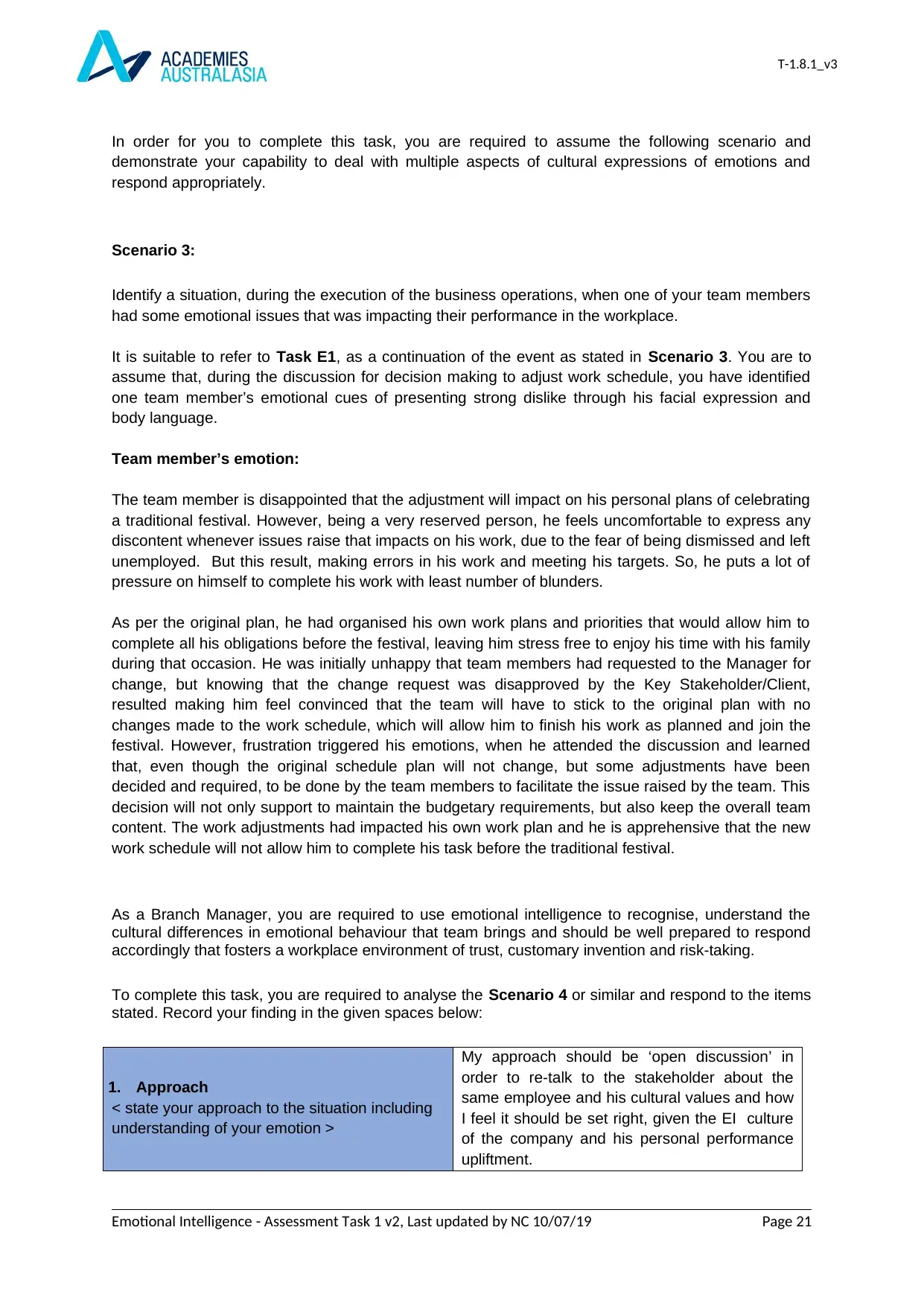
T-1.8.1_v3
In order for you to complete this task, you are required to assume the following scenario and
demonstrate your capability to deal with multiple aspects of cultural expressions of emotions and
respond appropriately.
Scenario 3:
Identify a situation, during the execution of the business operations, when one of your team members
had some emotional issues that was impacting their performance in the workplace.
It is suitable to refer to Task E1, as a continuation of the event as stated in Scenario 3. You are to
assume that, during the discussion for decision making to adjust work schedule, you have identified
one team member’s emotional cues of presenting strong dislike through his facial expression and
body language.
Team member’s emotion:
The team member is disappointed that the adjustment will impact on his personal plans of celebrating
a traditional festival. However, being a very reserved person, he feels uncomfortable to express any
discontent whenever issues raise that impacts on his work, due to the fear of being dismissed and left
unemployed. But this result, making errors in his work and meeting his targets. So, he puts a lot of
pressure on himself to complete his work with least number of blunders.
As per the original plan, he had organised his own work plans and priorities that would allow him to
complete all his obligations before the festival, leaving him stress free to enjoy his time with his family
during that occasion. He was initially unhappy that team members had requested to the Manager for
change, but knowing that the change request was disapproved by the Key Stakeholder/Client,
resulted making him feel convinced that the team will have to stick to the original plan with no
changes made to the work schedule, which will allow him to finish his work as planned and join the
festival. However, frustration triggered his emotions, when he attended the discussion and learned
that, even though the original schedule plan will not change, but some adjustments have been
decided and required, to be done by the team members to facilitate the issue raised by the team. This
decision will not only support to maintain the budgetary requirements, but also keep the overall team
content. The work adjustments had impacted his own work plan and he is apprehensive that the new
work schedule will not allow him to complete his task before the traditional festival.
As a Branch Manager, you are required to use emotional intelligence to recognise, understand the
cultural differences in emotional behaviour that team brings and should be well prepared to respond
accordingly that fosters a workplace environment of trust, customary invention and risk-taking.
To complete this task, you are required to analyse the Scenario 4 or similar and respond to the items
stated. Record your finding in the given spaces below:
1. Approach
< state your approach to the situation including
understanding of your emotion >
My approach should be ‘open discussion’ in
order to re-talk to the stakeholder about the
same employee and his cultural values and how
I feel it should be set right, given the EI culture
of the company and his personal performance
upliftment.
Emotional Intelligence - Assessment Task 1 v2, Last updated by NC 10/07/19 Page 21
In order for you to complete this task, you are required to assume the following scenario and
demonstrate your capability to deal with multiple aspects of cultural expressions of emotions and
respond appropriately.
Scenario 3:
Identify a situation, during the execution of the business operations, when one of your team members
had some emotional issues that was impacting their performance in the workplace.
It is suitable to refer to Task E1, as a continuation of the event as stated in Scenario 3. You are to
assume that, during the discussion for decision making to adjust work schedule, you have identified
one team member’s emotional cues of presenting strong dislike through his facial expression and
body language.
Team member’s emotion:
The team member is disappointed that the adjustment will impact on his personal plans of celebrating
a traditional festival. However, being a very reserved person, he feels uncomfortable to express any
discontent whenever issues raise that impacts on his work, due to the fear of being dismissed and left
unemployed. But this result, making errors in his work and meeting his targets. So, he puts a lot of
pressure on himself to complete his work with least number of blunders.
As per the original plan, he had organised his own work plans and priorities that would allow him to
complete all his obligations before the festival, leaving him stress free to enjoy his time with his family
during that occasion. He was initially unhappy that team members had requested to the Manager for
change, but knowing that the change request was disapproved by the Key Stakeholder/Client,
resulted making him feel convinced that the team will have to stick to the original plan with no
changes made to the work schedule, which will allow him to finish his work as planned and join the
festival. However, frustration triggered his emotions, when he attended the discussion and learned
that, even though the original schedule plan will not change, but some adjustments have been
decided and required, to be done by the team members to facilitate the issue raised by the team. This
decision will not only support to maintain the budgetary requirements, but also keep the overall team
content. The work adjustments had impacted his own work plan and he is apprehensive that the new
work schedule will not allow him to complete his task before the traditional festival.
As a Branch Manager, you are required to use emotional intelligence to recognise, understand the
cultural differences in emotional behaviour that team brings and should be well prepared to respond
accordingly that fosters a workplace environment of trust, customary invention and risk-taking.
To complete this task, you are required to analyse the Scenario 4 or similar and respond to the items
stated. Record your finding in the given spaces below:
1. Approach
< state your approach to the situation including
understanding of your emotion >
My approach should be ‘open discussion’ in
order to re-talk to the stakeholder about the
same employee and his cultural values and how
I feel it should be set right, given the EI culture
of the company and his personal performance
upliftment.
Emotional Intelligence - Assessment Task 1 v2, Last updated by NC 10/07/19 Page 21
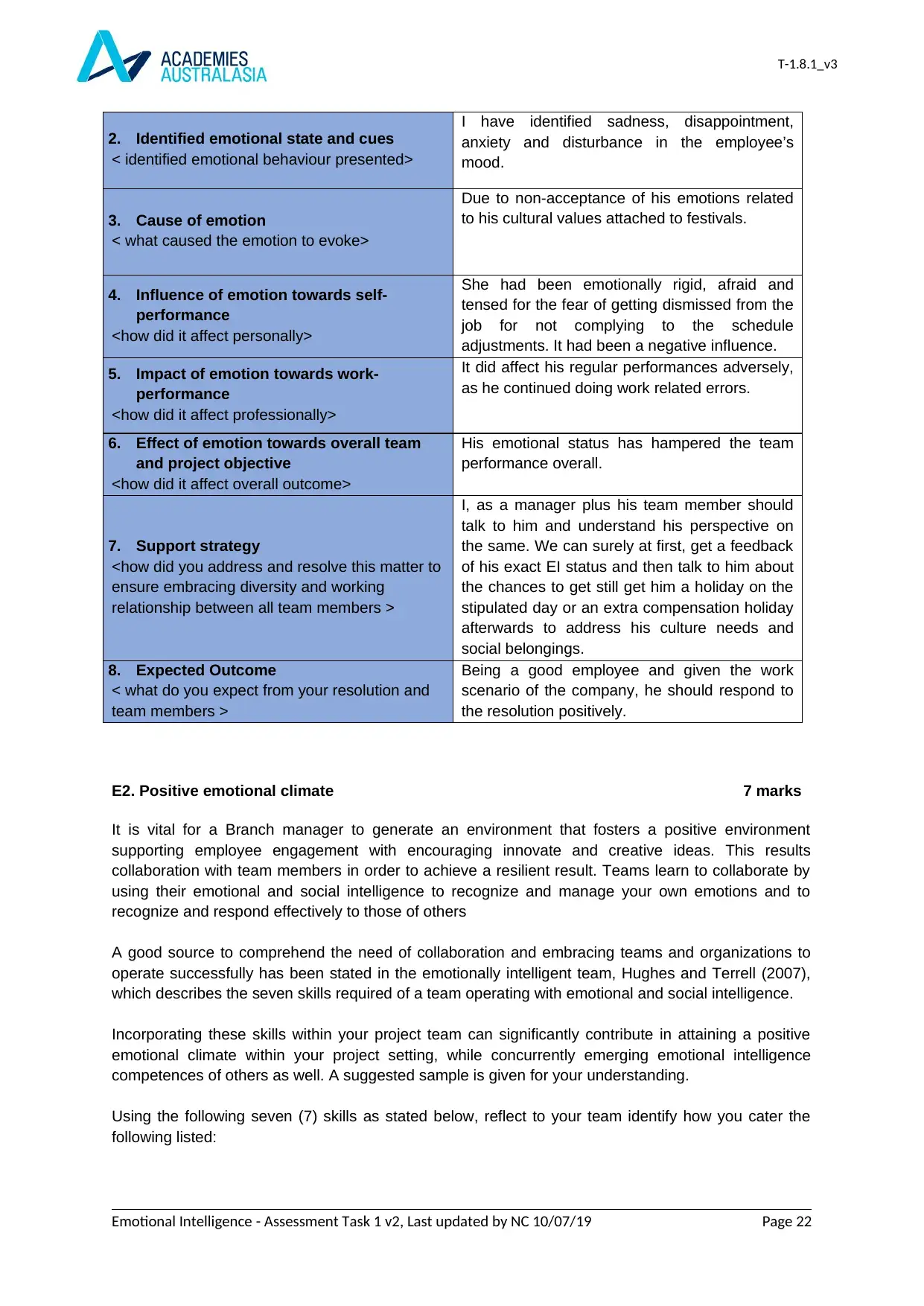
T-1.8.1_v3
2. Identified emotional state and cues
< identified emotional behaviour presented>
I have identified sadness, disappointment,
anxiety and disturbance in the employee’s
mood.
3. Cause of emotion
< what caused the emotion to evoke>
Due to non-acceptance of his emotions related
to his cultural values attached to festivals.
4. Influence of emotion towards self-
performance
<how did it affect personally>
She had been emotionally rigid, afraid and
tensed for the fear of getting dismissed from the
job for not complying to the schedule
adjustments. It had been a negative influence.
5. Impact of emotion towards work-
performance
<how did it affect professionally>
It did affect his regular performances adversely,
as he continued doing work related errors.
6. Effect of emotion towards overall team
and project objective
<how did it affect overall outcome>
His emotional status has hampered the team
performance overall.
7. Support strategy
<how did you address and resolve this matter to
ensure embracing diversity and working
relationship between all team members >
I, as a manager plus his team member should
talk to him and understand his perspective on
the same. We can surely at first, get a feedback
of his exact EI status and then talk to him about
the chances to get still get him a holiday on the
stipulated day or an extra compensation holiday
afterwards to address his culture needs and
social belongings.
8. Expected Outcome
< what do you expect from your resolution and
team members >
Being a good employee and given the work
scenario of the company, he should respond to
the resolution positively.
E2. Positive emotional climate 7 marks
It is vital for a Branch manager to generate an environment that fosters a positive environment
supporting employee engagement with encouraging innovate and creative ideas. This results
collaboration with team members in order to achieve a resilient result. Teams learn to collaborate by
using their emotional and social intelligence to recognize and manage your own emotions and to
recognize and respond effectively to those of others
A good source to comprehend the need of collaboration and embracing teams and organizations to
operate successfully has been stated in the emotionally intelligent team, Hughes and Terrell (2007),
which describes the seven skills required of a team operating with emotional and social intelligence.
Incorporating these skills within your project team can significantly contribute in attaining a positive
emotional climate within your project setting, while concurrently emerging emotional intelligence
competences of others as well. A suggested sample is given for your understanding.
Using the following seven (7) skills as stated below, reflect to your team identify how you cater the
following listed:
Emotional Intelligence - Assessment Task 1 v2, Last updated by NC 10/07/19 Page 22
2. Identified emotional state and cues
< identified emotional behaviour presented>
I have identified sadness, disappointment,
anxiety and disturbance in the employee’s
mood.
3. Cause of emotion
< what caused the emotion to evoke>
Due to non-acceptance of his emotions related
to his cultural values attached to festivals.
4. Influence of emotion towards self-
performance
<how did it affect personally>
She had been emotionally rigid, afraid and
tensed for the fear of getting dismissed from the
job for not complying to the schedule
adjustments. It had been a negative influence.
5. Impact of emotion towards work-
performance
<how did it affect professionally>
It did affect his regular performances adversely,
as he continued doing work related errors.
6. Effect of emotion towards overall team
and project objective
<how did it affect overall outcome>
His emotional status has hampered the team
performance overall.
7. Support strategy
<how did you address and resolve this matter to
ensure embracing diversity and working
relationship between all team members >
I, as a manager plus his team member should
talk to him and understand his perspective on
the same. We can surely at first, get a feedback
of his exact EI status and then talk to him about
the chances to get still get him a holiday on the
stipulated day or an extra compensation holiday
afterwards to address his culture needs and
social belongings.
8. Expected Outcome
< what do you expect from your resolution and
team members >
Being a good employee and given the work
scenario of the company, he should respond to
the resolution positively.
E2. Positive emotional climate 7 marks
It is vital for a Branch manager to generate an environment that fosters a positive environment
supporting employee engagement with encouraging innovate and creative ideas. This results
collaboration with team members in order to achieve a resilient result. Teams learn to collaborate by
using their emotional and social intelligence to recognize and manage your own emotions and to
recognize and respond effectively to those of others
A good source to comprehend the need of collaboration and embracing teams and organizations to
operate successfully has been stated in the emotionally intelligent team, Hughes and Terrell (2007),
which describes the seven skills required of a team operating with emotional and social intelligence.
Incorporating these skills within your project team can significantly contribute in attaining a positive
emotional climate within your project setting, while concurrently emerging emotional intelligence
competences of others as well. A suggested sample is given for your understanding.
Using the following seven (7) skills as stated below, reflect to your team identify how you cater the
following listed:
Emotional Intelligence - Assessment Task 1 v2, Last updated by NC 10/07/19 Page 22
Secure Best Marks with AI Grader
Need help grading? Try our AI Grader for instant feedback on your assignments.
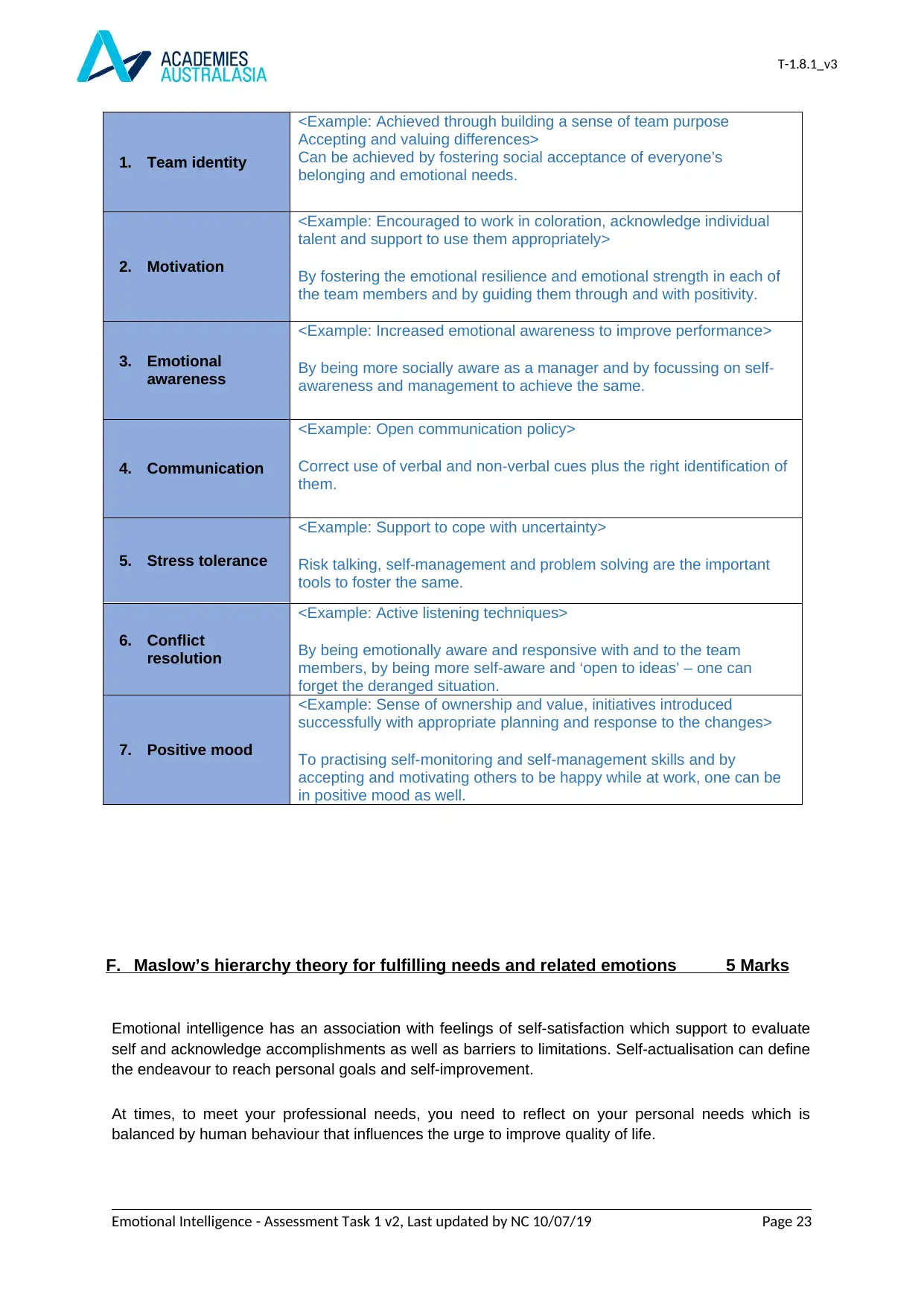
T-1.8.1_v3
1. Team identity
<Example: Achieved through building a sense of team purpose
Accepting and valuing differences>
Can be achieved by fostering social acceptance of everyone’s
belonging and emotional needs.
2. Motivation
<Example: Encouraged to work in coloration, acknowledge individual
talent and support to use them appropriately>
By fostering the emotional resilience and emotional strength in each of
the team members and by guiding them through and with positivity.
3. Emotional
awareness
<Example: Increased emotional awareness to improve performance>
By being more socially aware as a manager and by focussing on self-
awareness and management to achieve the same.
4. Communication
<Example: Open communication policy>
Correct use of verbal and non-verbal cues plus the right identification of
them.
5. Stress tolerance
<Example: Support to cope with uncertainty>
Risk talking, self-management and problem solving are the important
tools to foster the same.
6. Conflict
resolution
<Example: Active listening techniques>
By being emotionally aware and responsive with and to the team
members, by being more self-aware and ‘open to ideas’ – one can
forget the deranged situation.
7. Positive mood
<Example: Sense of ownership and value, initiatives introduced
successfully with appropriate planning and response to the changes>
To practising self-monitoring and self-management skills and by
accepting and motivating others to be happy while at work, one can be
in positive mood as well.
F. Maslow’s hierarchy theory for fulfilling needs and related emotions 5 Marks
Emotional intelligence has an association with feelings of self-satisfaction which support to evaluate
self and acknowledge accomplishments as well as barriers to limitations. Self-actualisation can define
the endeavour to reach personal goals and self-improvement.
At times, to meet your professional needs, you need to reflect on your personal needs which is
balanced by human behaviour that influences the urge to improve quality of life.
Emotional Intelligence - Assessment Task 1 v2, Last updated by NC 10/07/19 Page 23
1. Team identity
<Example: Achieved through building a sense of team purpose
Accepting and valuing differences>
Can be achieved by fostering social acceptance of everyone’s
belonging and emotional needs.
2. Motivation
<Example: Encouraged to work in coloration, acknowledge individual
talent and support to use them appropriately>
By fostering the emotional resilience and emotional strength in each of
the team members and by guiding them through and with positivity.
3. Emotional
awareness
<Example: Increased emotional awareness to improve performance>
By being more socially aware as a manager and by focussing on self-
awareness and management to achieve the same.
4. Communication
<Example: Open communication policy>
Correct use of verbal and non-verbal cues plus the right identification of
them.
5. Stress tolerance
<Example: Support to cope with uncertainty>
Risk talking, self-management and problem solving are the important
tools to foster the same.
6. Conflict
resolution
<Example: Active listening techniques>
By being emotionally aware and responsive with and to the team
members, by being more self-aware and ‘open to ideas’ – one can
forget the deranged situation.
7. Positive mood
<Example: Sense of ownership and value, initiatives introduced
successfully with appropriate planning and response to the changes>
To practising self-monitoring and self-management skills and by
accepting and motivating others to be happy while at work, one can be
in positive mood as well.
F. Maslow’s hierarchy theory for fulfilling needs and related emotions 5 Marks
Emotional intelligence has an association with feelings of self-satisfaction which support to evaluate
self and acknowledge accomplishments as well as barriers to limitations. Self-actualisation can define
the endeavour to reach personal goals and self-improvement.
At times, to meet your professional needs, you need to reflect on your personal needs which is
balanced by human behaviour that influences the urge to improve quality of life.
Emotional Intelligence - Assessment Task 1 v2, Last updated by NC 10/07/19 Page 23

T-1.8.1_v3
Abraham Maslow (1943) produced a model with a hierarchy of needs, that tends to support
individuals to comprehend what inspires people to escalate and be successful. The model states that
there is a need to fulfil your basic needs prior focusing on the higher level of needs.
Although Maslow's hierarchy is usually used as a personal psychology tool, this also can be adopted
to a project management setting, where an individual team member or the whole project team working
on the project tends to channel their way towards satisfying the succeeding needs with the
determination to surpass whatever impedes their work fulfilment.
The following diagram shows the how Maslow’s hierarchy is structured.
As a Manager, supporting your team members with opportunities to express their thoughts and
feelings is a step in the right direction towards fulfilling their fundamental needs in the workplace.
To be able to support your team achieve such fulfillments you too, as an individual, need to identify
internal factors that motivate your behavior to have a much happier life and feel accomplished. Only
then you can create a highly motivated and productive workforce.
Using the five levels in Maslow’s hierarchy of needs, outline how you have applied or can apply them
to fulfil your personal need as well as professional needs and state your related emotions for each
need:
Needs of Hierarchy Fulfilling your need
Emotional Intelligence - Assessment Task 1 v2, Last updated by NC 10/07/19 Page 24
Abraham Maslow (1943) produced a model with a hierarchy of needs, that tends to support
individuals to comprehend what inspires people to escalate and be successful. The model states that
there is a need to fulfil your basic needs prior focusing on the higher level of needs.
Although Maslow's hierarchy is usually used as a personal psychology tool, this also can be adopted
to a project management setting, where an individual team member or the whole project team working
on the project tends to channel their way towards satisfying the succeeding needs with the
determination to surpass whatever impedes their work fulfilment.
The following diagram shows the how Maslow’s hierarchy is structured.
As a Manager, supporting your team members with opportunities to express their thoughts and
feelings is a step in the right direction towards fulfilling their fundamental needs in the workplace.
To be able to support your team achieve such fulfillments you too, as an individual, need to identify
internal factors that motivate your behavior to have a much happier life and feel accomplished. Only
then you can create a highly motivated and productive workforce.
Using the five levels in Maslow’s hierarchy of needs, outline how you have applied or can apply them
to fulfil your personal need as well as professional needs and state your related emotions for each
need:
Needs of Hierarchy Fulfilling your need
Emotional Intelligence - Assessment Task 1 v2, Last updated by NC 10/07/19 Page 24
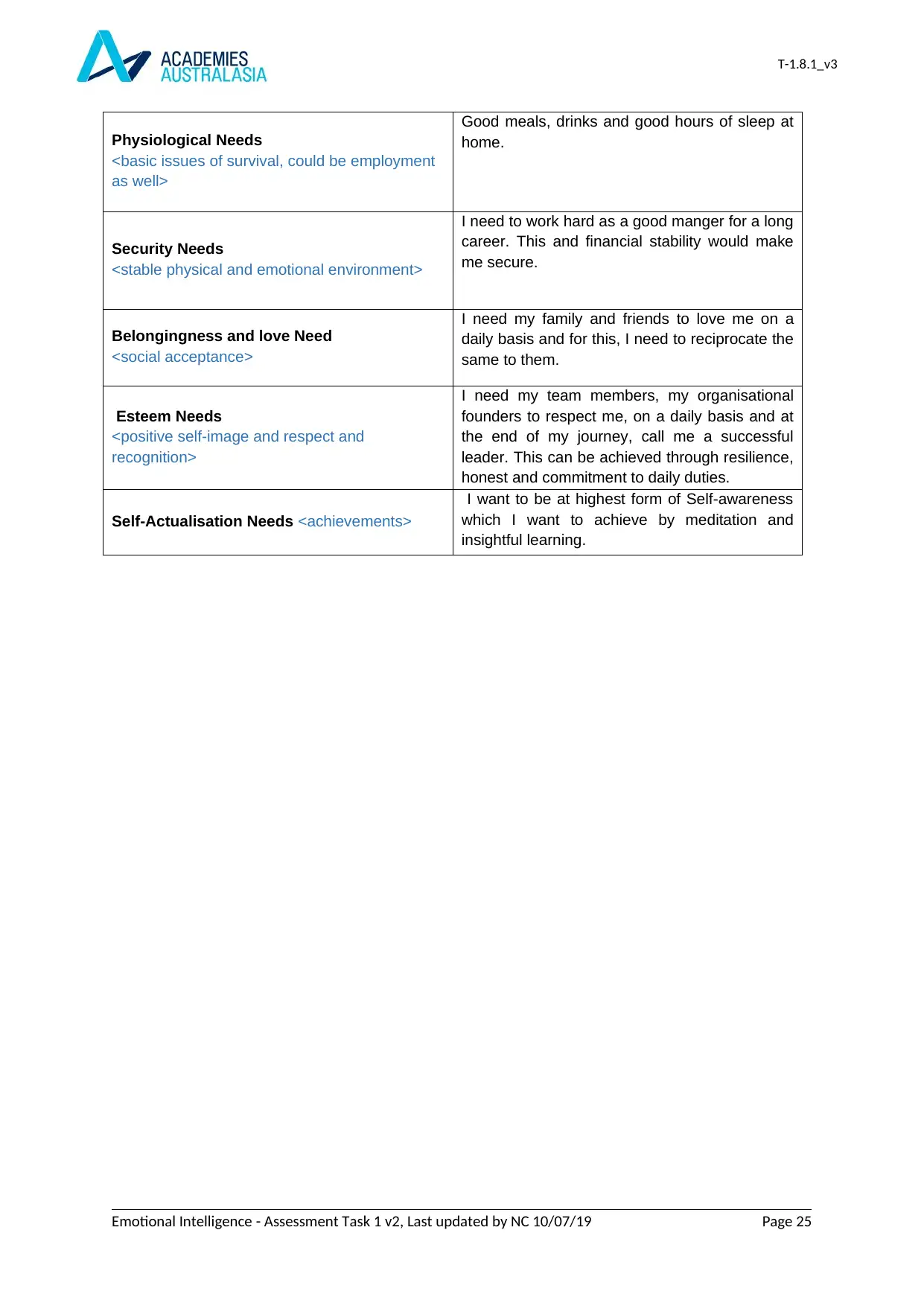
T-1.8.1_v3
Physiological Needs
<basic issues of survival, could be employment
as well>
Good meals, drinks and good hours of sleep at
home.
Security Needs
<stable physical and emotional environment>
I need to work hard as a good manger for a long
career. This and financial stability would make
me secure.
Belongingness and love Need
<social acceptance>
I need my family and friends to love me on a
daily basis and for this, I need to reciprocate the
same to them.
Esteem Needs
<positive self-image and respect and
recognition>
I need my team members, my organisational
founders to respect me, on a daily basis and at
the end of my journey, call me a successful
leader. This can be achieved through resilience,
honest and commitment to daily duties.
Self-Actualisation Needs <achievements>
I want to be at highest form of Self-awareness
which I want to achieve by meditation and
insightful learning.
Emotional Intelligence - Assessment Task 1 v2, Last updated by NC 10/07/19 Page 25
Physiological Needs
<basic issues of survival, could be employment
as well>
Good meals, drinks and good hours of sleep at
home.
Security Needs
<stable physical and emotional environment>
I need to work hard as a good manger for a long
career. This and financial stability would make
me secure.
Belongingness and love Need
<social acceptance>
I need my family and friends to love me on a
daily basis and for this, I need to reciprocate the
same to them.
Esteem Needs
<positive self-image and respect and
recognition>
I need my team members, my organisational
founders to respect me, on a daily basis and at
the end of my journey, call me a successful
leader. This can be achieved through resilience,
honest and commitment to daily duties.
Self-Actualisation Needs <achievements>
I want to be at highest form of Self-awareness
which I want to achieve by meditation and
insightful learning.
Emotional Intelligence - Assessment Task 1 v2, Last updated by NC 10/07/19 Page 25
Paraphrase This Document
Need a fresh take? Get an instant paraphrase of this document with our AI Paraphraser
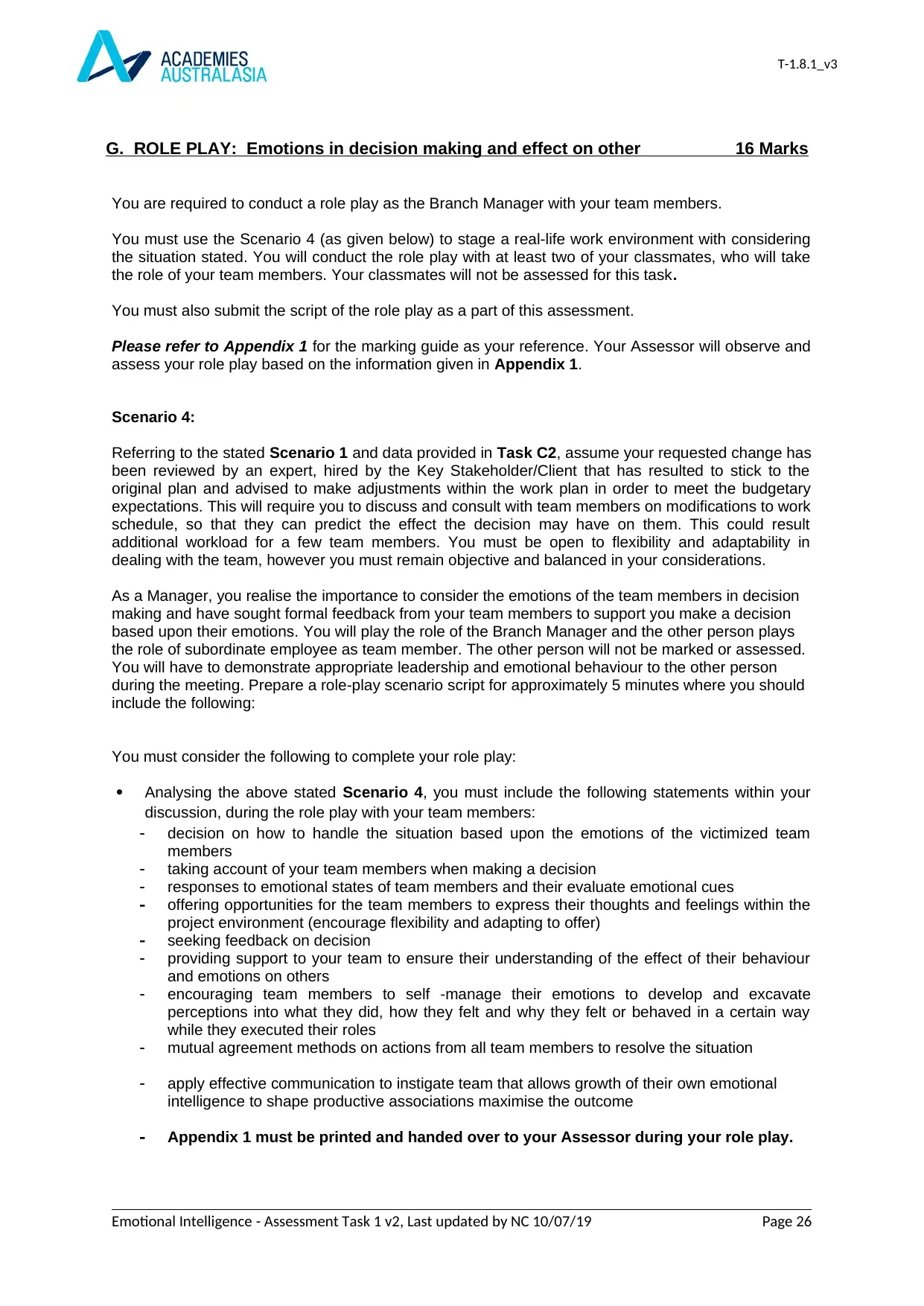
T-1.8.1_v3
G. ROLE PLAY: Emotions in decision making and effect on other 16 Marks
You are required to conduct a role play as the Branch Manager with your team members.
You must use the Scenario 4 (as given below) to stage a real-life work environment with considering
the situation stated. You will conduct the role play with at least two of your classmates, who will take
the role of your team members. Your classmates will not be assessed for this task.
You must also submit the script of the role play as a part of this assessment.
Please refer to Appendix 1 for the marking guide as your reference. Your Assessor will observe and
assess your role play based on the information given in Appendix 1.
Scenario 4:
Referring to the stated Scenario 1 and data provided in Task C2, assume your requested change has
been reviewed by an expert, hired by the Key Stakeholder/Client that has resulted to stick to the
original plan and advised to make adjustments within the work plan in order to meet the budgetary
expectations. This will require you to discuss and consult with team members on modifications to work
schedule, so that they can predict the effect the decision may have on them. This could result
additional workload for a few team members. You must be open to flexibility and adaptability in
dealing with the team, however you must remain objective and balanced in your considerations.
As a Manager, you realise the importance to consider the emotions of the team members in decision
making and have sought formal feedback from your team members to support you make a decision
based upon their emotions. You will play the role of the Branch Manager and the other person plays
the role of subordinate employee as team member. The other person will not be marked or assessed.
You will have to demonstrate appropriate leadership and emotional behaviour to the other person
during the meeting. Prepare a role-play scenario script for approximately 5 minutes where you should
include the following:
You must consider the following to complete your role play:
Analysing the above stated Scenario 4, you must include the following statements within your
discussion, during the role play with your team members:
decision on how to handle the situation based upon the emotions of the victimized team
members
taking account of your team members when making a decision
responses to emotional states of team members and their evaluate emotional cues
offering opportunities for the team members to express their thoughts and feelings within the
project environment (encourage flexibility and adapting to offer)
seeking feedback on decision
providing support to your team to ensure their understanding of the effect of their behaviour
and emotions on others
encouraging team members to self -manage their emotions to develop and excavate
perceptions into what they did, how they felt and why they felt or behaved in a certain way
while they executed their roles
mutual agreement methods on actions from all team members to resolve the situation
apply effective communication to instigate team that allows growth of their own emotional
intelligence to shape productive associations maximise the outcome
Appendix 1 must be printed and handed over to your Assessor during your role play.
Emotional Intelligence - Assessment Task 1 v2, Last updated by NC 10/07/19 Page 26
G. ROLE PLAY: Emotions in decision making and effect on other 16 Marks
You are required to conduct a role play as the Branch Manager with your team members.
You must use the Scenario 4 (as given below) to stage a real-life work environment with considering
the situation stated. You will conduct the role play with at least two of your classmates, who will take
the role of your team members. Your classmates will not be assessed for this task.
You must also submit the script of the role play as a part of this assessment.
Please refer to Appendix 1 for the marking guide as your reference. Your Assessor will observe and
assess your role play based on the information given in Appendix 1.
Scenario 4:
Referring to the stated Scenario 1 and data provided in Task C2, assume your requested change has
been reviewed by an expert, hired by the Key Stakeholder/Client that has resulted to stick to the
original plan and advised to make adjustments within the work plan in order to meet the budgetary
expectations. This will require you to discuss and consult with team members on modifications to work
schedule, so that they can predict the effect the decision may have on them. This could result
additional workload for a few team members. You must be open to flexibility and adaptability in
dealing with the team, however you must remain objective and balanced in your considerations.
As a Manager, you realise the importance to consider the emotions of the team members in decision
making and have sought formal feedback from your team members to support you make a decision
based upon their emotions. You will play the role of the Branch Manager and the other person plays
the role of subordinate employee as team member. The other person will not be marked or assessed.
You will have to demonstrate appropriate leadership and emotional behaviour to the other person
during the meeting. Prepare a role-play scenario script for approximately 5 minutes where you should
include the following:
You must consider the following to complete your role play:
Analysing the above stated Scenario 4, you must include the following statements within your
discussion, during the role play with your team members:
decision on how to handle the situation based upon the emotions of the victimized team
members
taking account of your team members when making a decision
responses to emotional states of team members and their evaluate emotional cues
offering opportunities for the team members to express their thoughts and feelings within the
project environment (encourage flexibility and adapting to offer)
seeking feedback on decision
providing support to your team to ensure their understanding of the effect of their behaviour
and emotions on others
encouraging team members to self -manage their emotions to develop and excavate
perceptions into what they did, how they felt and why they felt or behaved in a certain way
while they executed their roles
mutual agreement methods on actions from all team members to resolve the situation
apply effective communication to instigate team that allows growth of their own emotional
intelligence to shape productive associations maximise the outcome
Appendix 1 must be printed and handed over to your Assessor during your role play.
Emotional Intelligence - Assessment Task 1 v2, Last updated by NC 10/07/19 Page 26
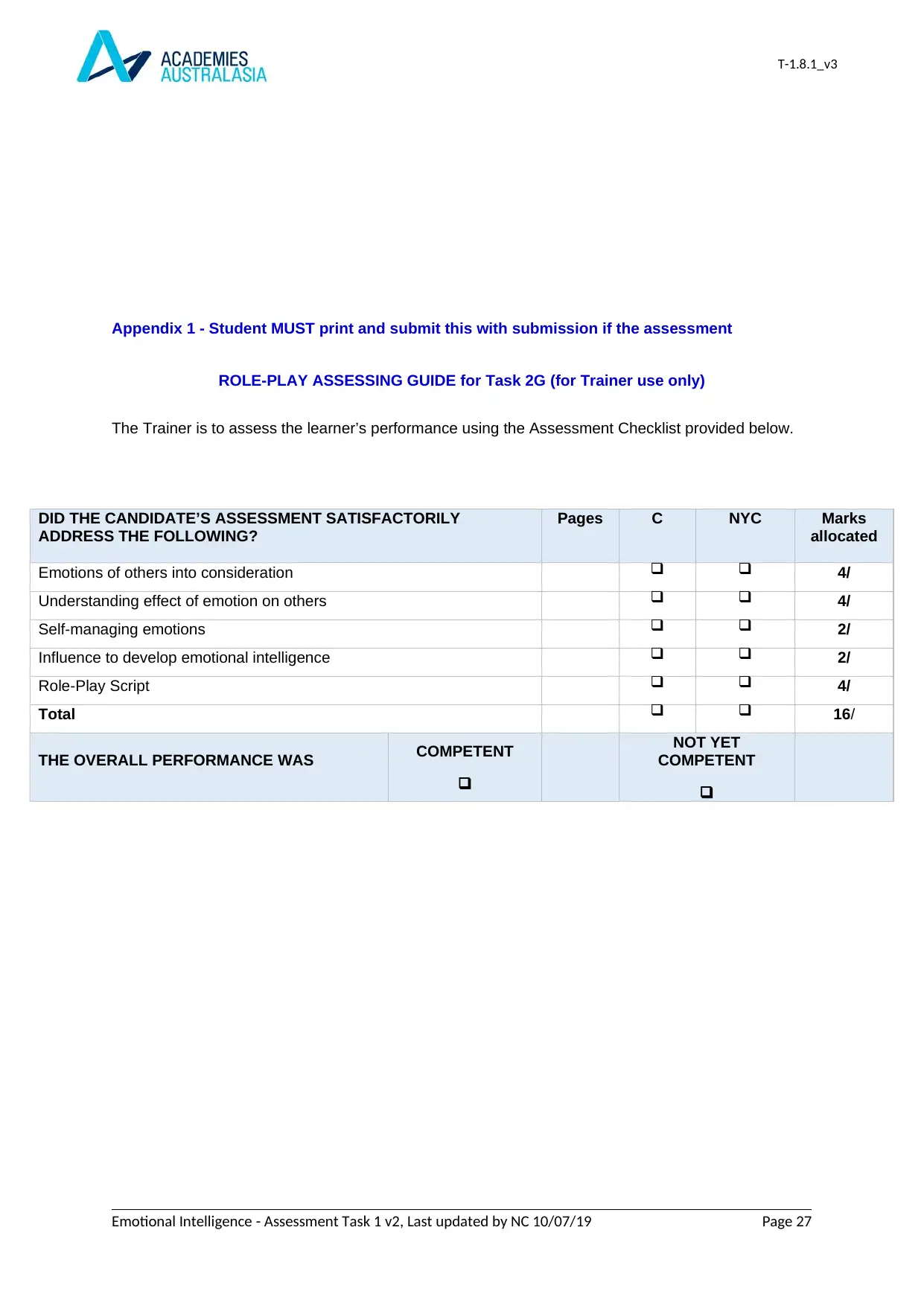
T-1.8.1_v3
Appendix 1 - Student MUST print and submit this with submission if the assessment
ROLE-PLAY ASSESSING GUIDE for Task 2G (for Trainer use only)
The Trainer is to assess the learner’s performance using the Assessment Checklist provided below.
DID THE CANDIDATE’S ASSESSMENT SATISFACTORILY
ADDRESS THE FOLLOWING?
Pages C NYC Marks
allocated
Emotions of others into consideration 4/
Understanding effect of emotion on others 4/
Self-managing emotions 2/
Influence to develop emotional intelligence 2/
Role-Play Script 4/
Total 16/
THE OVERALL PERFORMANCE WAS COMPETENT
NOT YET
COMPETENT
Emotional Intelligence - Assessment Task 1 v2, Last updated by NC 10/07/19 Page 27
Appendix 1 - Student MUST print and submit this with submission if the assessment
ROLE-PLAY ASSESSING GUIDE for Task 2G (for Trainer use only)
The Trainer is to assess the learner’s performance using the Assessment Checklist provided below.
DID THE CANDIDATE’S ASSESSMENT SATISFACTORILY
ADDRESS THE FOLLOWING?
Pages C NYC Marks
allocated
Emotions of others into consideration 4/
Understanding effect of emotion on others 4/
Self-managing emotions 2/
Influence to develop emotional intelligence 2/
Role-Play Script 4/
Total 16/
THE OVERALL PERFORMANCE WAS COMPETENT
NOT YET
COMPETENT
Emotional Intelligence - Assessment Task 1 v2, Last updated by NC 10/07/19 Page 27
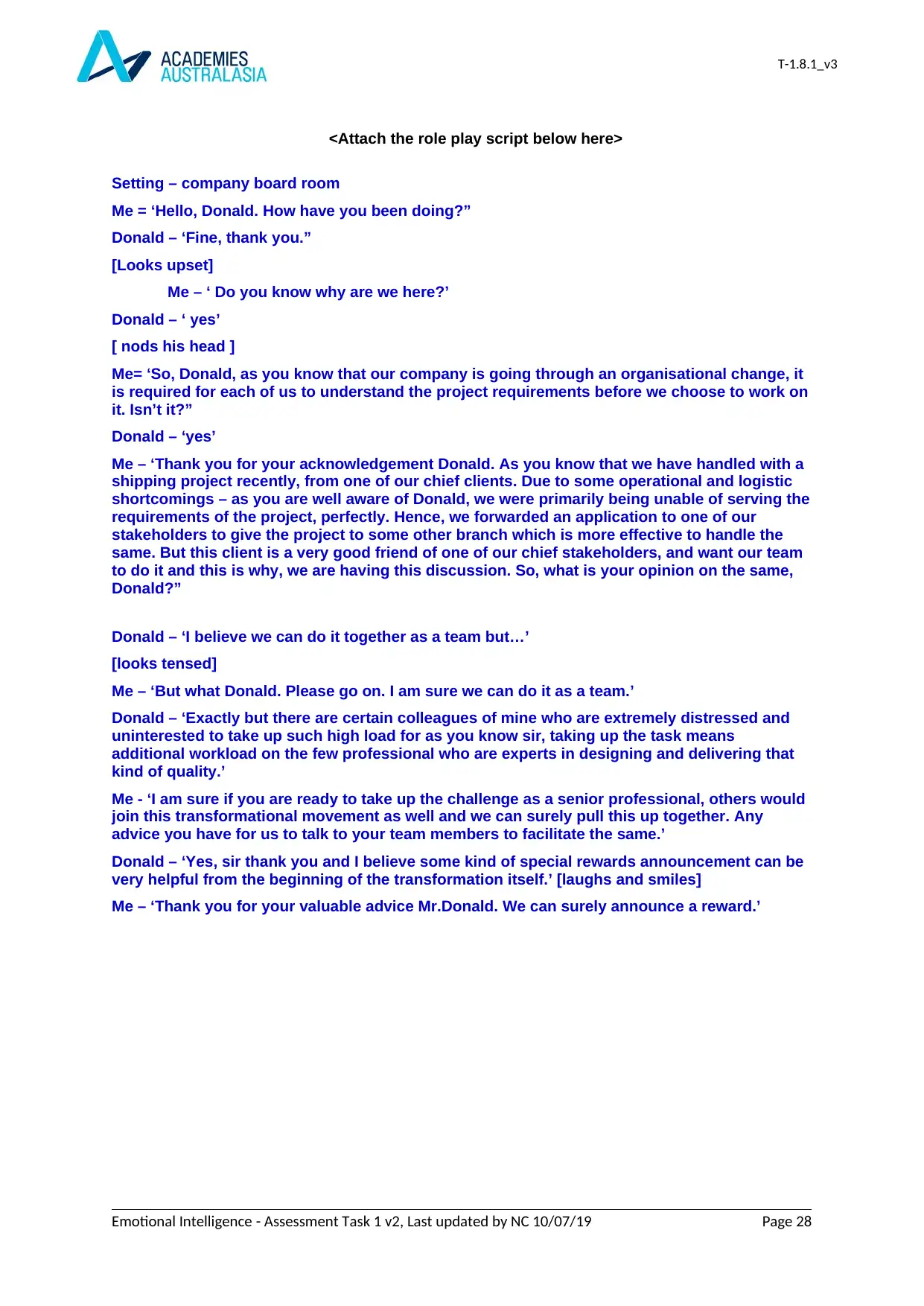
T-1.8.1_v3
<Attach the role play script below here>
Setting – company board room
Me = ‘Hello, Donald. How have you been doing?”
Donald – ‘Fine, thank you.”
[Looks upset]
Me – ‘ Do you know why are we here?’
Donald – ‘ yes’
[ nods his head ]
Me= ‘So, Donald, as you know that our company is going through an organisational change, it
is required for each of us to understand the project requirements before we choose to work on
it. Isn’t it?”
Donald – ‘yes’
Me – ‘Thank you for your acknowledgement Donald. As you know that we have handled with a
shipping project recently, from one of our chief clients. Due to some operational and logistic
shortcomings – as you are well aware of Donald, we were primarily being unable of serving the
requirements of the project, perfectly. Hence, we forwarded an application to one of our
stakeholders to give the project to some other branch which is more effective to handle the
same. But this client is a very good friend of one of our chief stakeholders, and want our team
to do it and this is why, we are having this discussion. So, what is your opinion on the same,
Donald?”
Donald – ‘I believe we can do it together as a team but…’
[looks tensed]
Me – ‘But what Donald. Please go on. I am sure we can do it as a team.’
Donald – ‘Exactly but there are certain colleagues of mine who are extremely distressed and
uninterested to take up such high load for as you know sir, taking up the task means
additional workload on the few professional who are experts in designing and delivering that
kind of quality.’
Me - ‘I am sure if you are ready to take up the challenge as a senior professional, others would
join this transformational movement as well and we can surely pull this up together. Any
advice you have for us to talk to your team members to facilitate the same.’
Donald – ‘Yes, sir thank you and I believe some kind of special rewards announcement can be
very helpful from the beginning of the transformation itself.’ [laughs and smiles]
Me – ‘Thank you for your valuable advice Mr.Donald. We can surely announce a reward.’
Emotional Intelligence - Assessment Task 1 v2, Last updated by NC 10/07/19 Page 28
<Attach the role play script below here>
Setting – company board room
Me = ‘Hello, Donald. How have you been doing?”
Donald – ‘Fine, thank you.”
[Looks upset]
Me – ‘ Do you know why are we here?’
Donald – ‘ yes’
[ nods his head ]
Me= ‘So, Donald, as you know that our company is going through an organisational change, it
is required for each of us to understand the project requirements before we choose to work on
it. Isn’t it?”
Donald – ‘yes’
Me – ‘Thank you for your acknowledgement Donald. As you know that we have handled with a
shipping project recently, from one of our chief clients. Due to some operational and logistic
shortcomings – as you are well aware of Donald, we were primarily being unable of serving the
requirements of the project, perfectly. Hence, we forwarded an application to one of our
stakeholders to give the project to some other branch which is more effective to handle the
same. But this client is a very good friend of one of our chief stakeholders, and want our team
to do it and this is why, we are having this discussion. So, what is your opinion on the same,
Donald?”
Donald – ‘I believe we can do it together as a team but…’
[looks tensed]
Me – ‘But what Donald. Please go on. I am sure we can do it as a team.’
Donald – ‘Exactly but there are certain colleagues of mine who are extremely distressed and
uninterested to take up such high load for as you know sir, taking up the task means
additional workload on the few professional who are experts in designing and delivering that
kind of quality.’
Me - ‘I am sure if you are ready to take up the challenge as a senior professional, others would
join this transformational movement as well and we can surely pull this up together. Any
advice you have for us to talk to your team members to facilitate the same.’
Donald – ‘Yes, sir thank you and I believe some kind of special rewards announcement can be
very helpful from the beginning of the transformation itself.’ [laughs and smiles]
Me – ‘Thank you for your valuable advice Mr.Donald. We can surely announce a reward.’
Emotional Intelligence - Assessment Task 1 v2, Last updated by NC 10/07/19 Page 28
1 out of 28
Related Documents
Your All-in-One AI-Powered Toolkit for Academic Success.
+13062052269
info@desklib.com
Available 24*7 on WhatsApp / Email
![[object Object]](/_next/static/media/star-bottom.7253800d.svg)
Unlock your academic potential
© 2024 | Zucol Services PVT LTD | All rights reserved.



